A Son’s Devotion on the Ganga’s Edge
Some stories do not rush. They arrive when the heart is ready—softly, like dawn after a long night.
This story is more than a travelogue—it’s a soul’s journey through grief, ritual, and renewal at the sacred banks of the Ganga.
As you walk with me through Haridwar, you’ll not only witness the quiet power of farewell, but also discover practical wisdom woven into every step: from train routes and temple timings to sacred mantras.
It’s a tribute, not just a trip—each moment honors my parent’s legacy and may help you reflect on your own.
If you’ve ever lost someone, or wondered how to honor them meaningfully, this blog offers a gentle roadmap.
It blends emotion and logistics, poetry and precision, crafted for those who seek depth—not just directions. And by the end, you may not just understand my journey—you may feel inspired to begin your own.
23 Years of Devotion and Farewell
On August 17th, 2025, I parted with my most unwavering guide—my mother—after 23 devoted years of caregiving.
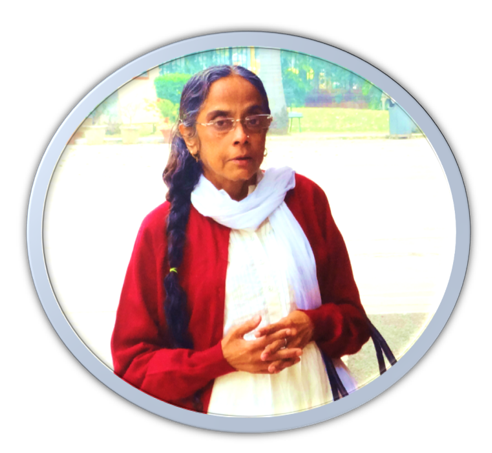
Her journey with rheumatoid arthritis was marked by quiet strength, and mine by steadfast love.
This post gathers the memories we shared, the rituals we performed in her honor, and the legacy she left behind.
It is offered with tenderness—for anyone walking through grief, seeking not just comfort, but a sense of sacred continuity.
Ganga’s Murky Embrace at the Emerald Foothills
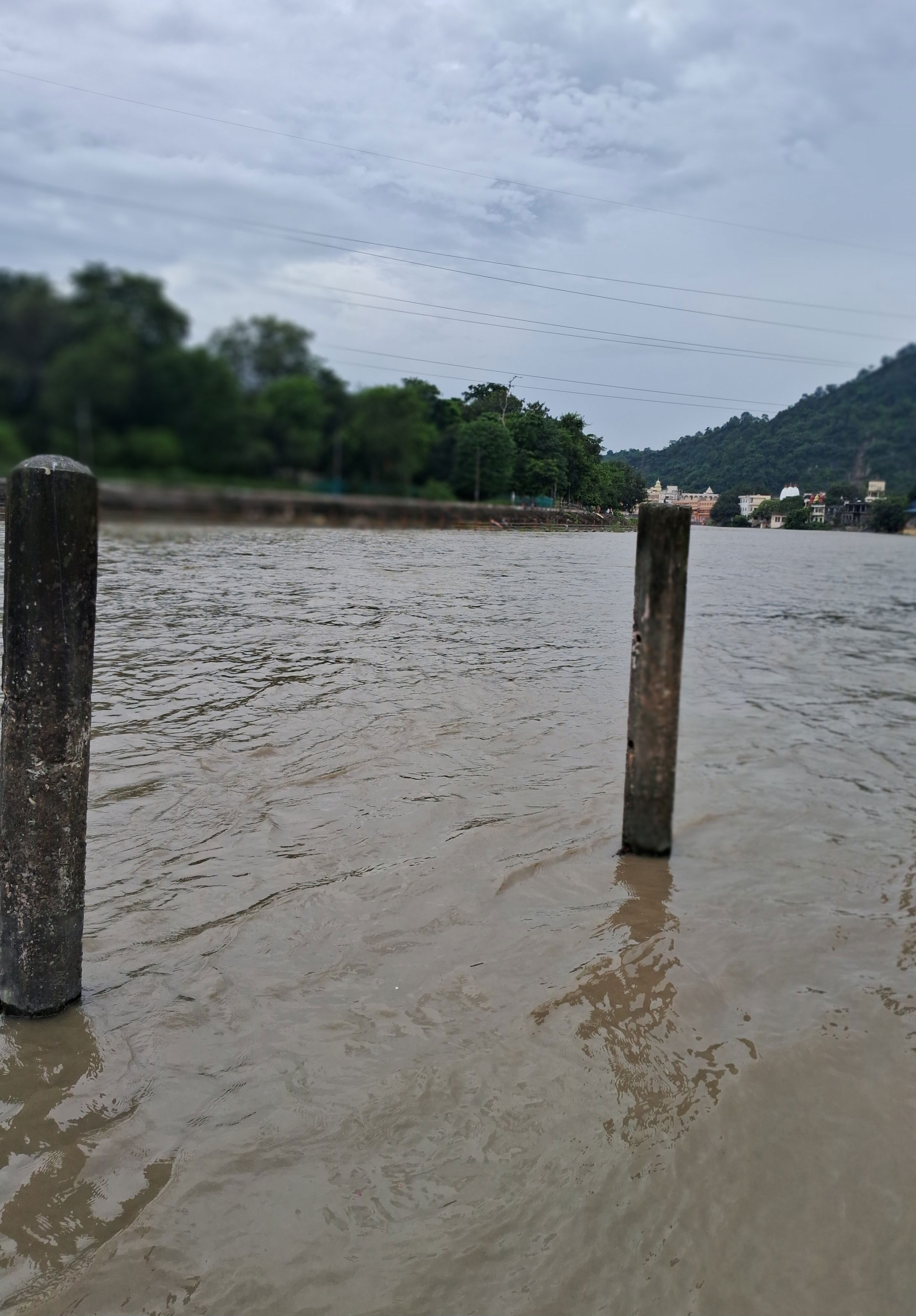
At the ghat’s edge, two weathered posts rose from the brown water like silent guardians.
I stood in reverent stillness, the humid monsoon air wrapping around me as if in shared pause.
Beyond the swirling sediment, the Himalaya foothills wore a living emerald cloak, clouds drifting across ridges in soft wisps.
The river’s murky flow mirrored the weight in my chest—each gentle ripple a quiet echo of our years together.
In that hushed moment, I did not think about her ashes but let my gaze drift between water and mountain, feeling grief and gratitude converge in nature’s timeless embrace.
Every memory we made together now flows through the currents of my heart.
“Some journeys are not taken because we want to travel, but because life has already placed the responsibility in our hands. I did not choose this role; it unfolded around me, day by day, year after year, until my mother’s life and my care for her became one continuous thread. Twenty‑three years of watching over her taught me that love is not always loud — sometimes it is quiet persistence, a thousand small acts that no one else sees. And when the time came to walk beside her to the banks of the Ganga for her final journey, I realised that perhaps it was never about being chosen at all… but about choosing, again and again, to stay.”
Diksha, Devotion, Departure
On the evening of Janmashtami, August 16th, my mother’s health began to fade—quietly, as if in rhythm with the divine.
She used to sing bhajans in Bengali, her voice soft and devoted, yearning for a place at the feet of God - "Hori din to gaelo, shonda holo, paar koro aamare". Means, O Hari, the days have passed, evening has fallen—please help me cross over.
By sunrise on August 17th, 2025, forty-six years of unconditional warmth—of being held through storms and sunshine—folded gently into a single, sacred moment.
That morning light felt like both a greeting and a farewell.
What she was praying for years was granted by Lord Vishnu on Janmashtami.
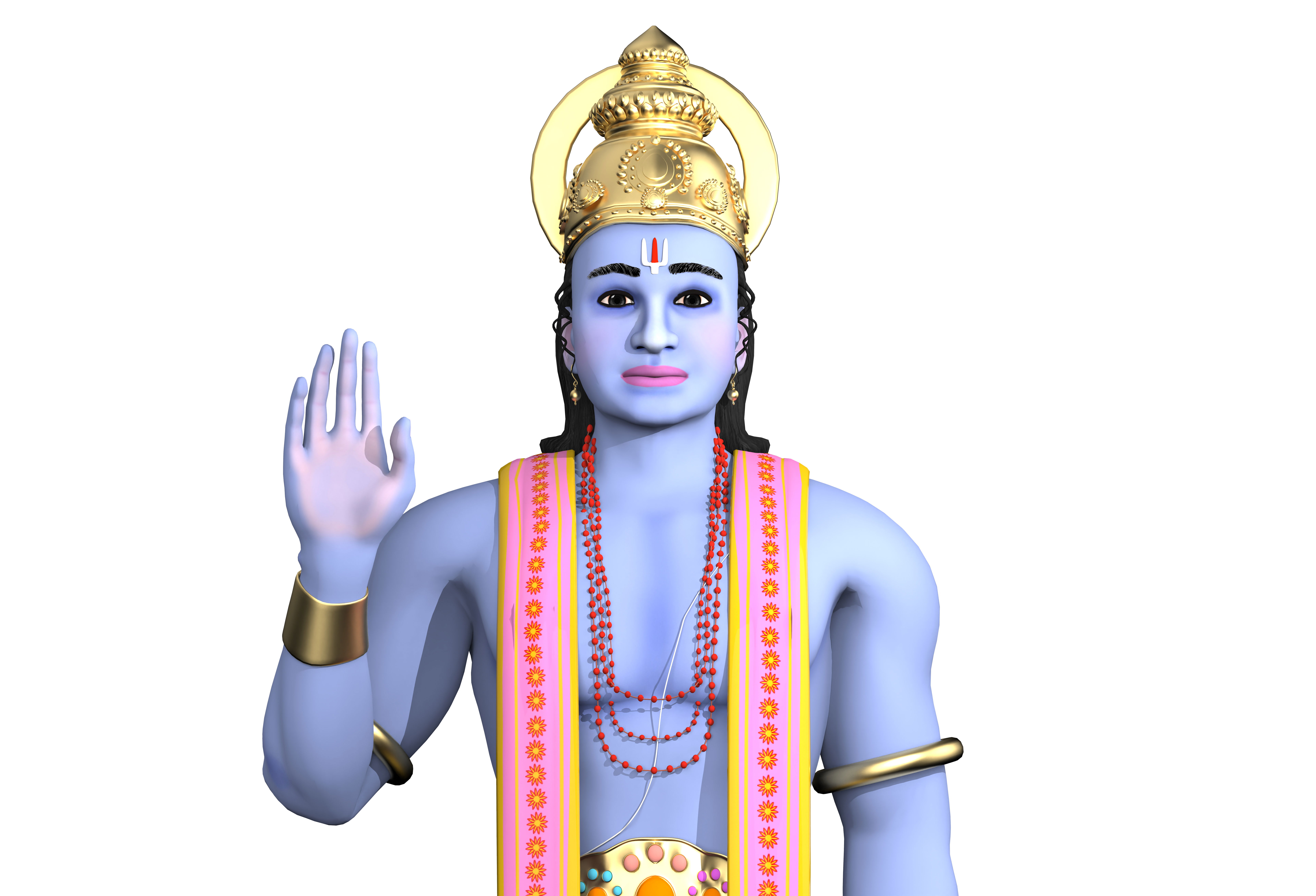
As I stood by her bedside, the weight of seven decades—of monsoon rains, golden dawns, and whispered lullabies—seemed to pass through the room.
I whispered my gratitude, not just for the years, but for the grace with which she lived them.
She had taken diksha from the Ramakrishna Mission, her faith rooted in the teachings of Ram and Krishna—both incarnations of Lord Vishnu.
And on the day of Krishna’s birth, I saw the divine cradle her final breath. Her journey was blessed. Her devotion answered.
Honoring Her Final Wish
When the doctor confirmed her passing—a truth no son is ever truly prepared to receive—the world fell into a hush.
In that suspended moment, Baisakhi didi and Arvind jijaji quietly took charge, arranging both the doctor and the ambulance with grace and urgency.
Inside the cool hush of the air-conditioned ambulance, I sat beside my mother, joined by my elder sister Suparna and Arvind jijaji. Together, we began the solemn journey to Nigambodh Ghat.
She had always wished to be laid to rest where her parents’ pyres once burned—on the sacred banks of the Yamuna.
In honoring that final wish, I made a silent vow: to carry out every last ritual with devotion and dignity.
Baisakhi didi returned home, her part in this tender passage complete.
Later, at Nigambodh Ghat, our mami ji joined us—another thread in the fabric of farewell.
Reserved for Renewal: Durga Puja Kaftan and Holy Waters
I wrapped her in a new kaftan, I’d reserved for the coming Durga Puja—a quiet tribute to her grace and the festival’s promise of renewal..
On the ghat, the priest’s solemn chants rose for her soul’s onward journey. Garlands of marigolds and bright petals crowned her with a quiet dignity.
Her body was bathed in the confluence of the Ganga and Yamuna—two rivers, two lifelines—whose combined waters purified her for the voyage beyond.
Rain of Blessings: A Son’s Farewell at Nigam Bodh Ghat
The wooden pyre stood ready, cedar logs stacked like whispered prayers—her second wish fulfilled in that hallowed space.
Suddenly, rain swept across the ghat in a monsoon downpour. I lifted my face, letting the cold droplets mingle with my tears, feeling as if the heavens themselves had come to offer solace.
With trembling lips, I kissed her forehead one last time. Steeling my heart, I completed her final rites at the river’s edge and watched the flame carry her spirit into light.
I was deeply impressed by both the arrangements and the demeanor of those managing Nigambodh Ghat. There was no sense of haste, no trace of rudeness—only a quiet patience that allowed each step of the process to unfold with dignity and care.
One aspect that could be improved is the clear display of fixed rates for puja samagri and the Purohit’s fee. Negotiating or debating such matters at a cremation ground feels uncomfortable and out of place, especially during moments that call for quiet dignity and focus.
🕊️ Pillars of Grace 🕊️
From the very first day, Shubhro Dada, Uma Didi, and Shambhu Dada—my paternal family—stood by me and my sister, Suparna with quiet strength and unwavering care.
On the evening of my mother’s passing, they arrived at our home bearing fruits, honey, cornflakes, and financial support.
But more than offerings, they brought presence—steady, compassionate, and deeply rooted in love.
Through every ritual, every ceremony, they remained by our side.
Not just as relatives, but as pillars of grace—holding space for sorrow, tradition, and remembrance.
The Kalash Waits: A Son’s Journey Begins
On the dawn of August 18th, I rose at 4 a.m.to begin the nine-day ritual of offering meals to my mother’s soul—morning and before sunset, in disposable bowls and glasses, each filled with the dishes she loved in her final days.
With the first offering laid out, I traveled to Vikaspuri to pick Arvind Jijaji.
At exactly 9 a.m., we arrived together at Nigambodh Ghat, ready to collect her ashes in a clay urn.
A priest welcomed us with quiet dignity, guiding us through the sacred requirements—what materials were needed, and where to find them along the ghat’s edge.
In quiet reverence, we placed my mother’s asthi into a simple clay kalash—an offering of earth to hold her essence, as tradition and love intertwined in silence.
Once the asthi were gathered into the kalash, the priest invited me to sit upon the āsan.
With practiced serenity, he began to chant the mantras.
Just then, a cow wandered near—unbidden, unhurried—as if drawn by the sanctity of the moment, offering her silent blessings.
After the puja was complete, we gave Dakshina to the priest.
He guided us with entrusting the kalash to the ghat’s locker room, where it would remain for the next fifteen days—the maximum time permitted.
Before placing it inside, the attendant gently instructed us to fold our hands, speak to her soul, and promise: We will return to take you to Haridwar.
We did as we were told. With quiet hearts, we placed the kalash into the drawer and departed for home.
🌿 A Promise in Silence 🌿
On August 19th, I visited Bubi Masi’s home—a place now steeped in quiet grief.
Just a year ago, she lost her young daughter so suddenly, and since then, the world has felt unbearably empty for her.
Together with Baisakhi Didi and Arvind Jijaji, we stood by her side during those final rites, helping carry the weight of farewell with as much tenderness as we could offer.
That day, amidst soft conversation and shared memory, Bubi Masi expressed a wish that moved me deeply: she asked that I perform her cremation when her time comes, just as I had done for my mother.
Her love for me stretches back to the days when I was cradled in my mother’s lap—unspoken, unwavering, and unconditional.
I gave her my quiet yes.
The rest, as always, rests in the hands of God.
💛 A Gift of Grace and Remembrance 💛
Bubi Masi handed me a substantial cheque on behalf of her elder sister, Rina Chand Chopra, and her family.
We lovingly call her Fintu Masi—a woman with a generous heart, always ready to help without hesitation or fanfare.
I expressed my heartfelt thanks to both of them—first in person, then again over the phone—and quietly deposited the cheque into my bank.
It wasn’t just financial support; it was a gesture woven with love, memory, and shared devotion.
Ten Mornings of Remembrance
Starting from 17th August, over next 10 unrelenting dawns, each sunrise ushered in its own rite—and with every offering of food, incense, and whispered mantra, fresh tears welled unbidden.
I moved through each ceremony as though walking a threshold laid with both grief and grace.
In the silent pauses between chants, time itself seemed to stretch and shatter, borne aloft on the steady rhythm of prayer and the tender ache of remembrance.
In those days of ritual, relatives and friends brought what they could—monetary help, food and fruits, new clothes, puja materials—each contribution smoothing the way for the ceremonies ahead.
Alongside my elder cousin sister Uma didi, I sat down to design a simple, elegant invitation card for Mother’s Shradh ceremony—an open hand extended to all who would join us in honouring her memory.
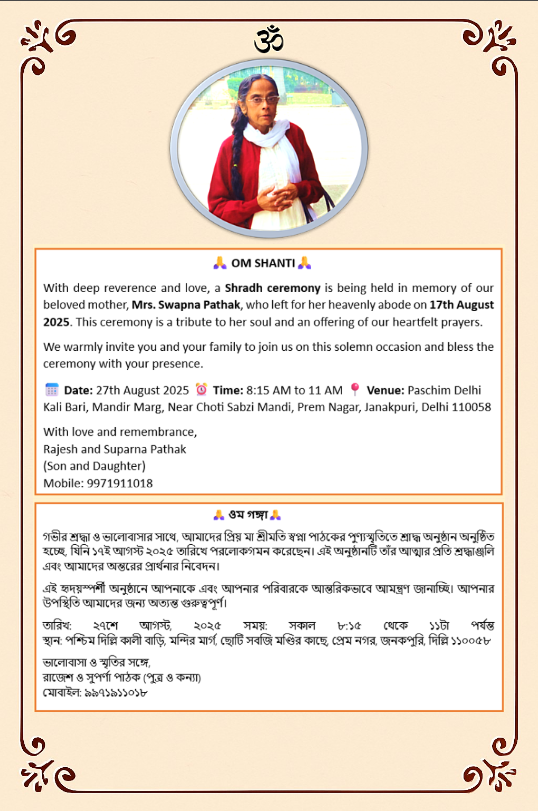
Ekadashi Vrat: A Sacred Beginning
On Tuesday, 19th August, I observed my first Ekadashi fast—a quiet yet profound initiation into a year-long spiritual commitment.
Guided by the wisdom of my paternal relative Shambhu dada, I was instructed to abstain from grains, especially rice, and sustain myself solely on fruits throughout the day.
This ritual, steeped in tradition and reverence, marked the beginning of a twelve-month journey of discipline, devotion, and inner reflection
Eighth Dawn of Solace: Tea, Tales, and Shared Grief
On the eighth dawn, my college friend Jitendra arrived with his wife, stepping quietly into our home to pay homage to my mother.
Shortly thereafter, cousins Rajdeep dada and Uma didi joined us, their faces reflecting the same tenderness born of personal loss.
Over steaming cups of chai, we exchanged stories of rituals performed and loved ones remembered—each tale a bridge of empathy, weaving our grief into a shared tapestry of comfort and understanding.
Ninth Dawn: Threshold of Ritual: Shradh, Shaving, and the Haridwar Calling
Ninth day went busy with scheduling the coming few important days including shaving head, shradh ceremony and Haridwar yatra.
🌳 Under the Peepal, Toward Peace 🌳
On the tenth dawn, August 26th, I gathered all the puja materials and food offerings that had been lovingly prepared for my mother’s soul over the past nine days.
Each item held memory, each gesture a whisper of devotion.
At 7 a.m., I reached Paschim Delhi Kali Bari.
An e-rickshaw carried me to a towering Peepal tree—its roots deep, its presence sacred.
Beneath its shade, I placed the bag of offerings, surrendering them to the earth as tradition calls.
Ghatkamano: A Passage of Grace
Returning to the temple, I met the priest, Subroto Chatterjee, who guided me to a makeshift pond for the ghatkamano ritual—a sacred rite of passage for the departed.
There, I performed pind daan, offering symbolic pinds to my mother’s soul.
Head Bowed, Heart Lifted
The ritual continued with the shaving of my head, beard, and moustache, and the trimming of nails by a barber—an act of humility and purification.
A small shikha was left on my head as required for brahmins.
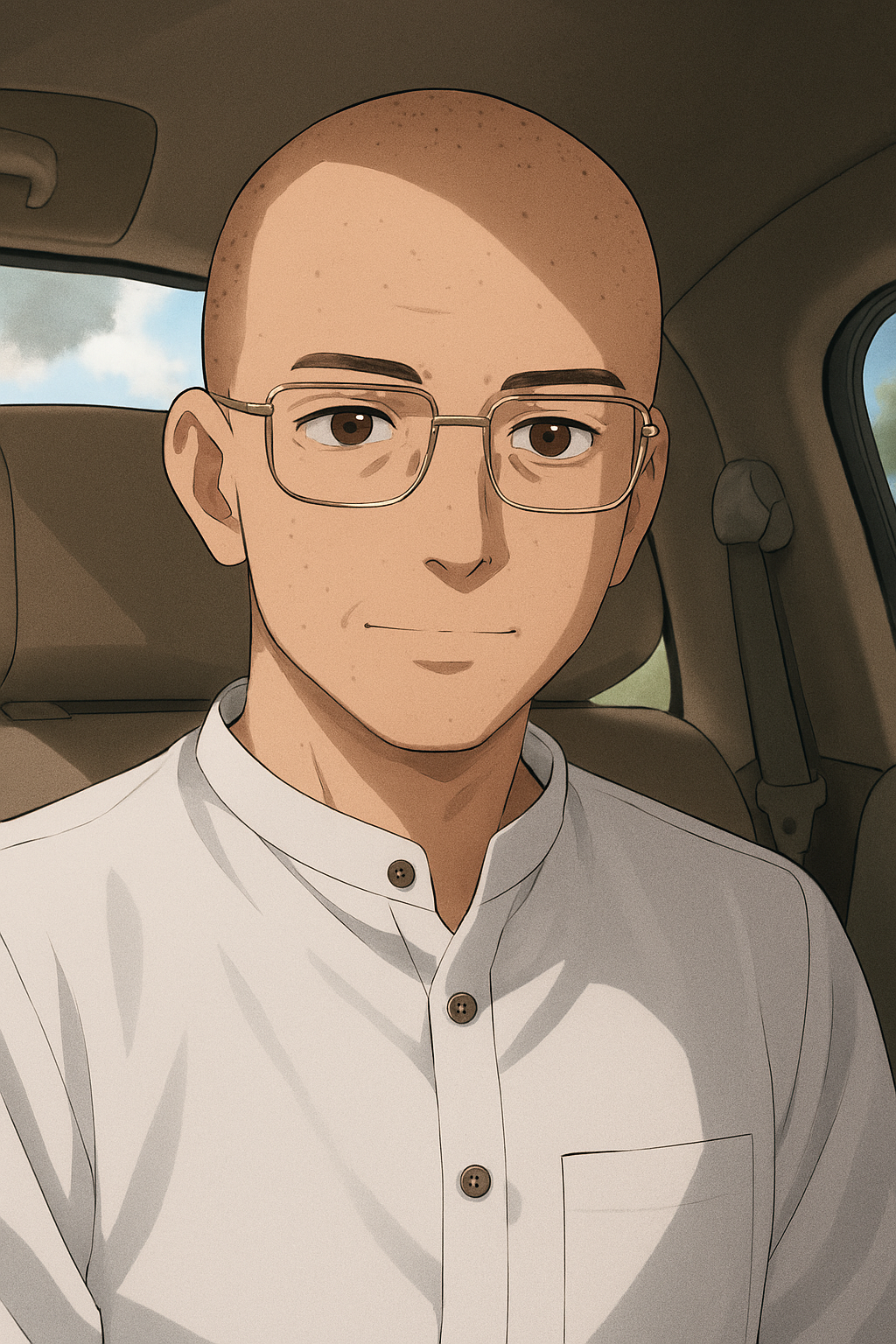
Brahmins shave their heads—symbolizing purity, humility, and readiness for the remaining ceremonies.
Shikha guides the soul’s departure. The Shikha is traditionally kept at the crown of the head, which corresponds to the Sahasrara Chakra—the highest energy center in yogic philosophy.
- It symbolizes spiritual focus, purity, and devotion.
- In Vedic rituals, it’s believed that the soul exits the body through the Sahasrara, and the Shikha helps guide that transition.
- It’s also seen as a mark of discipline and readiness for sacred duties like chanting mantras, performing yajnas, or engaging in spiritual study.
I offered the barber a generous sum, not just for his service, but for the role he played in this sacred farewell.
Purification, Mishri and Incense
Returning home, I bathed, letting each drop wash away dust and the weight of the day.
I then cleansed every corner of the house and the puja room—each sweep of the cloth a silent prayer for purity and peace.
As evening fell, I placed gleaming mishri crystals before the deity.
I lit incense sticks, watching curling wisps of smoke carry my gratitude and hopes upward.
🌺 When the Gods Walk Together 🌺
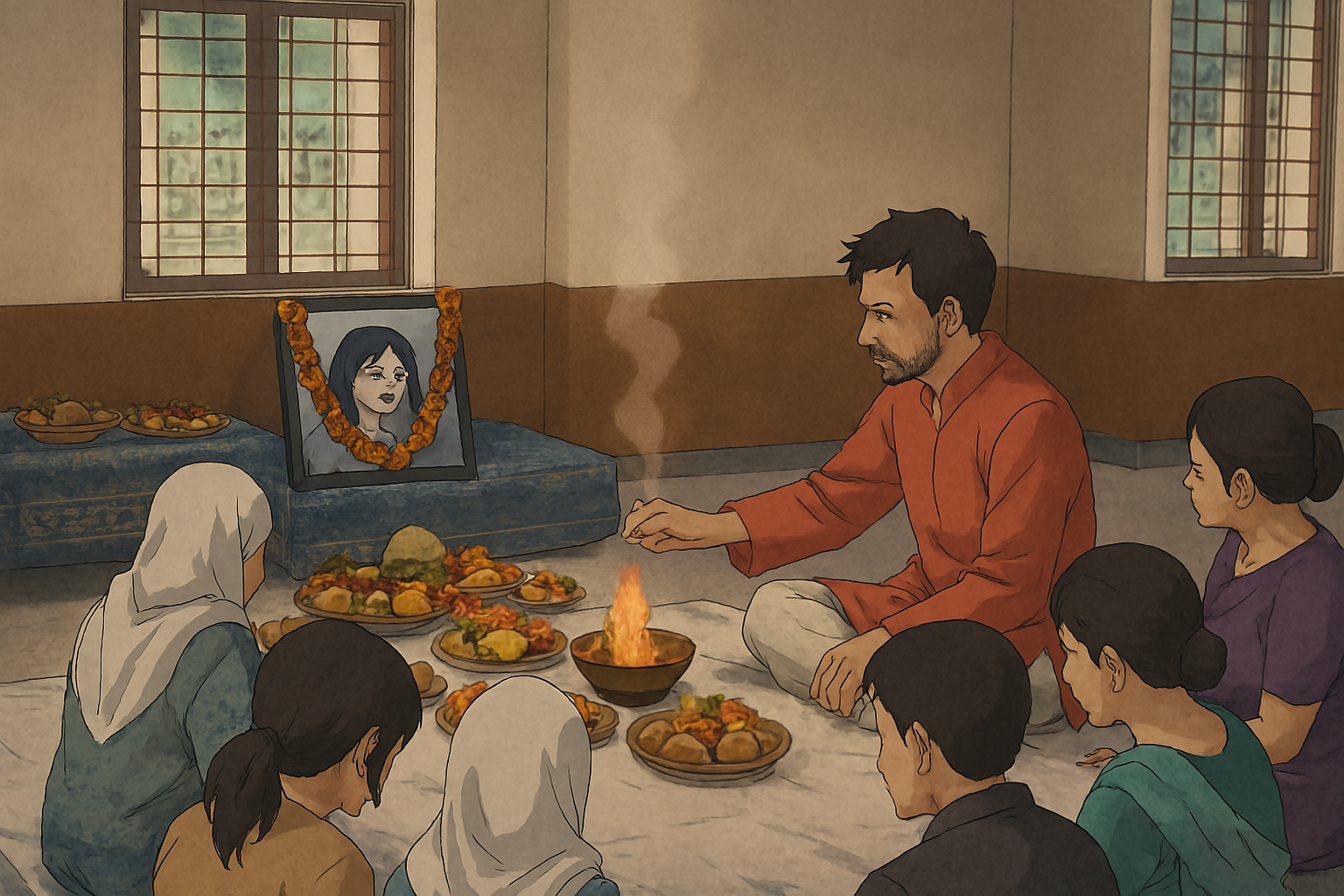
On August 27th, the eleventh day, we observed the Shradh ceremony—a word so brief, yet so profound, it stirs the soul.
Shradh is not merely a ritual. It is remembrance woven with reverence, love offered in silence to those who shaped our lives and now reside beyond sight.
That same day, the air echoed with the joyous chants of Ganesh Chaturthi.
Two sacred observances—one solemn, one celebratory—unfolded side by side, as if the heavens themselves had orchestrated a divine harmony.
It felt as though my mother was doubly blessed.
Vishnu, the preserver of cosmic order, and Ganesh, the remover of obstacles, both watching over her journey.
In that sacred overlap, I saw grace. I saw protection.
I saw her being carried gently by the gods she revered—wrapped in light, lifted by devotion.
🌼 Where Silence Became Sacred 🌼
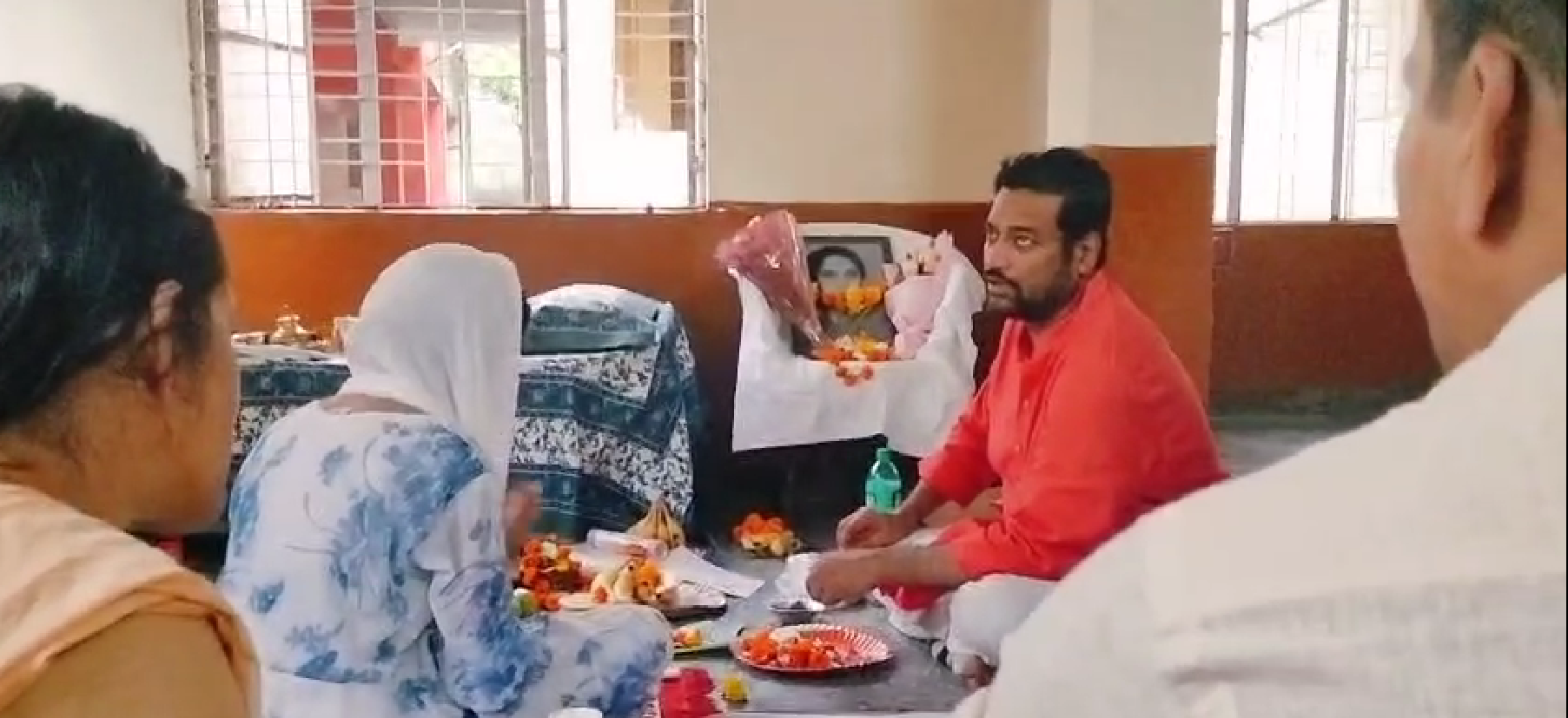
The Shradh puja began.
Clad in a crisp white dhoti and kurta, I settled beside the priest on a woven mat.
Under the priest’s steady guidance, my sister and I performed the puja, our chants rising and falling like gentle waves.
As his mantras rose, each verse seemed to lift our shared memories skyward—an offering shaped by love and loss in equal measure.
Uma Didi arrived first, carrying the flower bouquet I had requested.
With quiet grace, she placed it beside my mother’s photograph, just next to the one I had laid myself.
Two bouquets, side by side—two hearts remembering one soul.
Soft whispers and folded hands wove through the hush, infusing the space with a prayerful reverence.
Arvind Jijaji came with Baisakhi Didi.
Then Shambhu Dada arrived with his family.
The puja continued, the offerings flowed, and so did the arrival of those invited—each presence a thread in the tapestry of remembrance.
Mamiji visited with her daughter, bringing quiet comfort in a moment of need.
With gentle hands and heartfelt intent, she placed her financial contribution into mine—a gesture that spoke more than words ever could.
Shubhro Dada and Santosh arrived with their respective families.
And with that, the gathering was complete.
In that sacred stillness, surrounded by love and ritual, I felt the weight of memory and the lightness of grace.
My mother was being honored not just in rites, but in the hearts that came together to remember her.
Rain as Blessing, Chant as Offering
Heavy rain fell in earnest, each drop echoing divine approval of our ritual and bringing Ma’s soul a gentle serenity.
When the concluding mantra melted away, we presented dakshina to the priest and his fellow Brahmins, conveying our profound appreciation.
🍽️ A Feast of Memory and Gratitude 🍽️
As Bengali tradition lovingly dictates, the ceremony concluded with a humble yet heartfelt feast: crisp luchis puffed to perfection, fragrant aloo dum rich with warmth, and two varieties of sweets that carried the quiet sweetness of remembrance.
Each plate was more than food—it was a gesture of gratitude, a silent thank-you to every soul who came to honor her memory.
In every bite, tradition met tenderness. In every flavor, love lingered
Sustenance and Solidarity: The Twelfth Day’s Ritual Meal
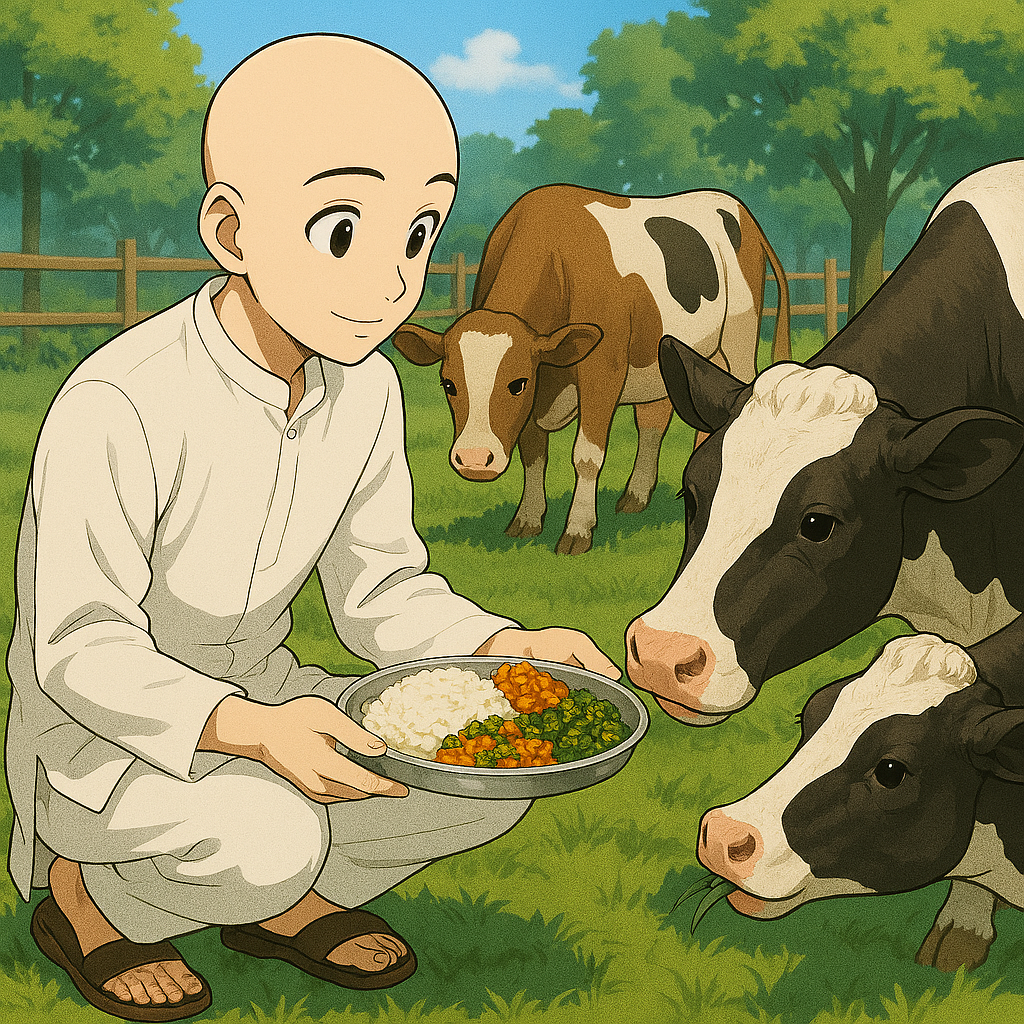
The twelfth day of mourning was sacredly set aside for Maach Porosh—our father’s ritual of communal nourishment offered to Bhairav.
In my hands, a thali brimmed with steaming rice and an assortment of cooked vegetables meant for the cow, alongside a small portion of fish destined for dog.
As a vegetarian, the weight of that fish on my conscience pressed heavily, yet I honored the rite’s call above my own discomfort.
By fortune’s quiet grace, an elderly rickshaw puller guided me into a hidden grove of emerald grass, where gentle cows roamed beneath a monsoon-soft sky.
I stepped into the hush, clutching the meal my elder cousin Rajdeep had sent with devoted care.
Before me stood a doe-eyed cow and a black dog.
In silence, I offered each bite to Bhairav, letting the ritual unfold as softly as a whispered mantra carried on the breeze.
Later, back home under the same rain-kissed air, Rajdeep dada laid out a simple feast of saag and rice.
The kitchen filled with warm, leafy aromas that seemed to mend the space between heartache and hope.
We shared that meal—each spoonful a taste of gratitude and family solace—before I turned my thoughts to the next step in my pilgrimage.
As twilight deepened, I gathered my belongings for the train to Haridwar, carrying with me the memory of grace, ritual, and renewal.
The Cab at 4 A.M.

At 4 a.m., a pre-booked cab arrived quietly at my doorstep.
Bathed and dressed in a simple white kurta-pyjama, my feet in humble slippers, I stepped into the pale morning, ready for the journey that had waited years to unfold.
I handed the luggage to the driver, who placed it with care, and took the back seat.
We were bound for Shambhu dada’s home to pick him and his son.
A Companion Found Before Dawn
By 4:30 a.m., I reached their place. Snehashish, his son, met me for the first time—but with such warmth, it felt as though we’d known each other for years.
I was grateful for the companionship, a quiet blessing for the road ahead.
The Kalash and the Journey Ahead
By 5 a.m., the three of us arrived at Nigambodh Ghat and waited near the gate, the car still and silent.
At 5:30, we entered and received the kalash holding my mother’s final remains.
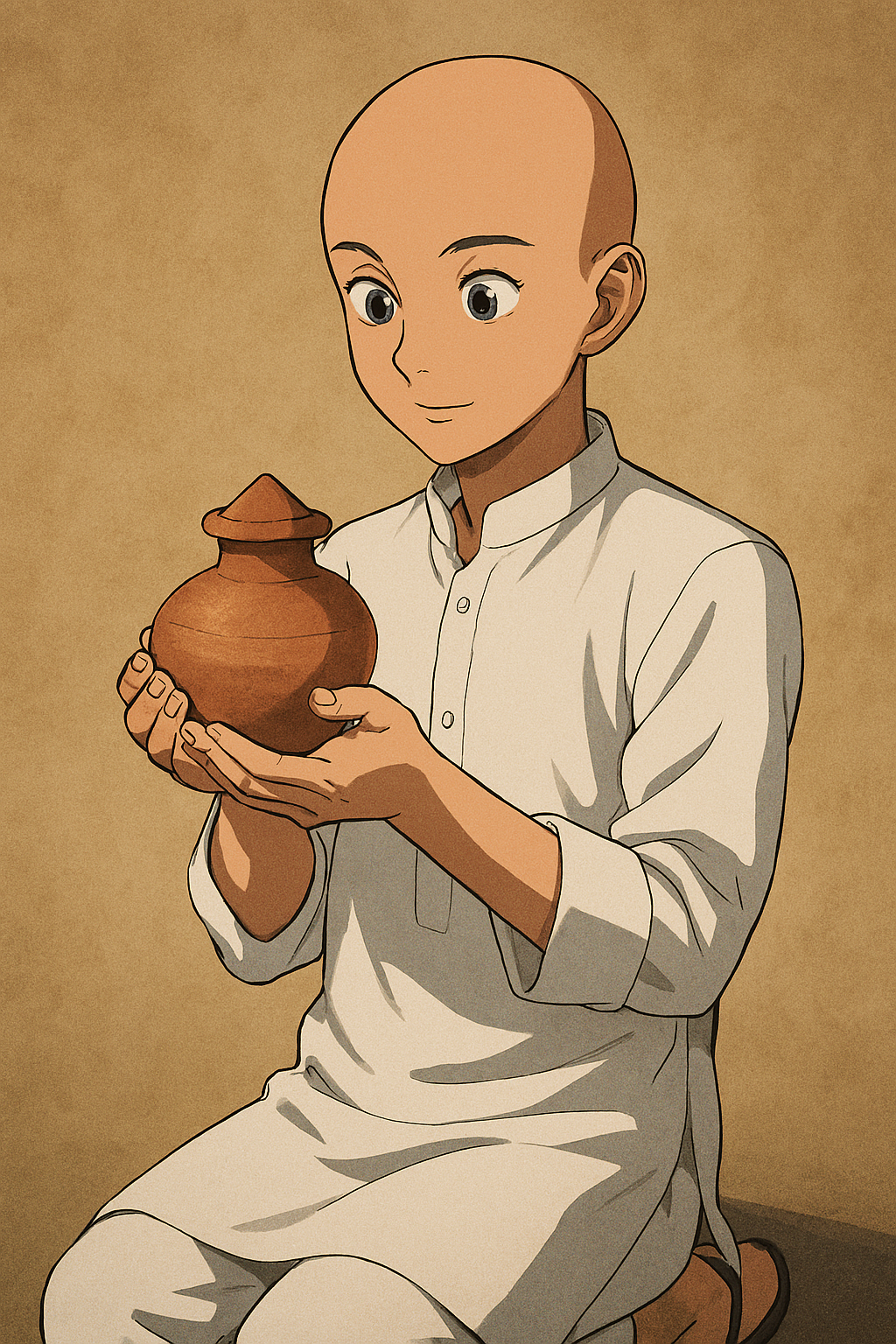
I gently replaced the faded marigold garland with a fresh one, and we were asked to offer prayers for her soul.
Then, with reverence and resolve, we returned to the car and made our way to New Delhi Railway Station.
Somnath ji, the Bengali priest I had invited to lead the asthi visarjan, was arriving separately to confirm the platform number for the Delhi–Dehradun Shatabdi Express.
At New Delhi Railway station

Bathed in the hush of early light, our small procession moved with quiet purpose—a pilgrimage long postponed, now unfolding.
The journey to the station felt sacred, each mile steeped in reverence and anticipation.
In my hands, I cradled a simple clay urn inside a bag, holding my mother’s ashes—each grain a lifetime of memory, each breath a silent prayer.
Amid the bustle of New Delhi Railway Station, my humble sandals whispered against the platform stones.

Walking beside me were three companions: Somnath ji, carrying the weight of ritual wisdom; Shambhu dada, whose quiet strength anchored us; and young Snehashish, whose gentle curiosity reminded us that life, even in mourning, continues to bloom.
The world surged around me, yet in my grasp, time stood still.
The Train to Ganga
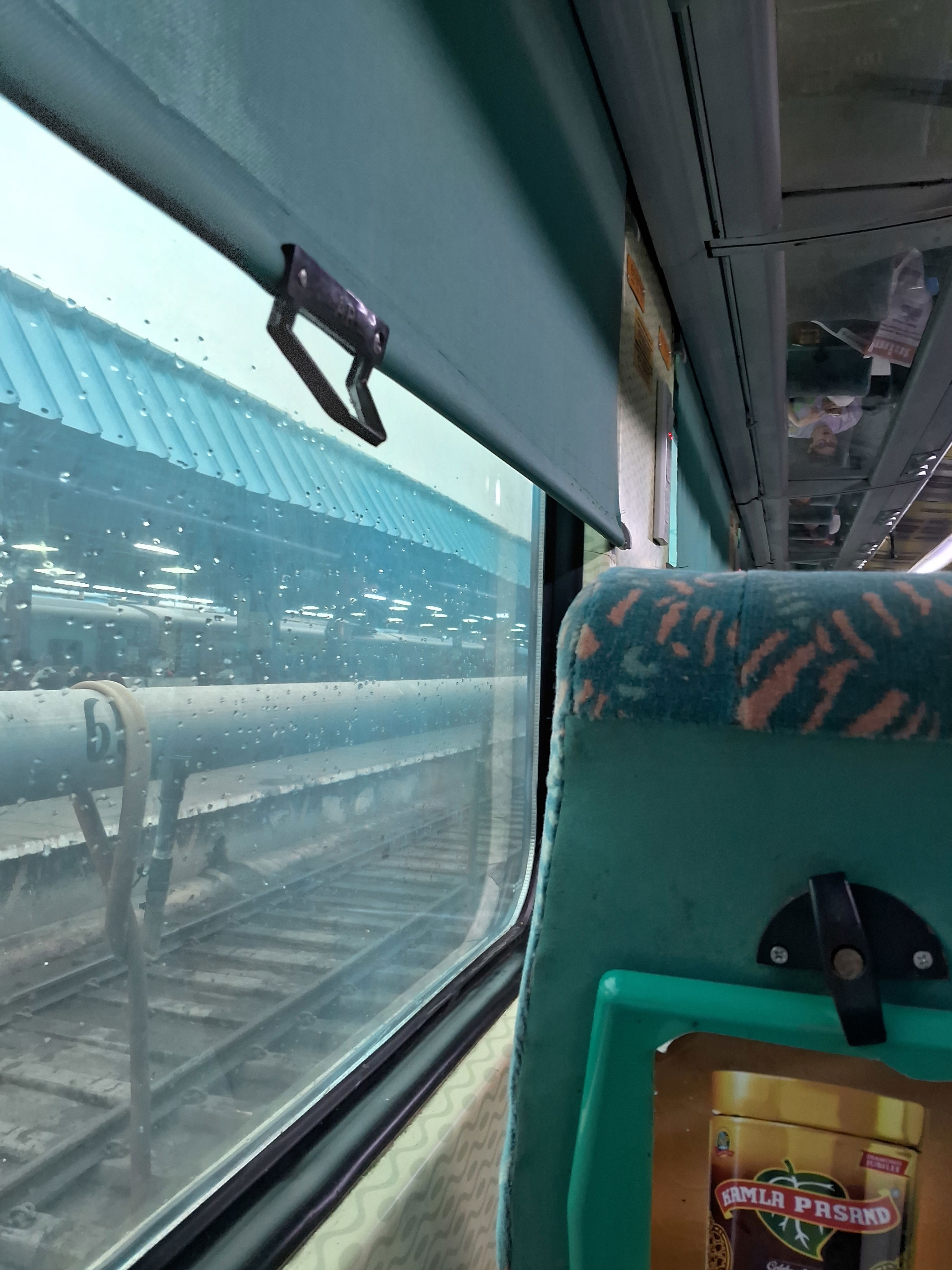
At 6:55 a.m., the Shatabdi Express began its slow departure.
Its rhythmic clatter beneath my palms echoed like a heartbeat of remembrance.
Rain-dappled fields unfurled beyond the window, each village a silent witness to my devotion.
This was more than a journey to the Ganga. It was a son’s final act of love—a sacred offering carried not just in clay, but in memory, in silence, and in the steady rhythm of farewell.
Mapping the Soul’s Journey: A Five-Hour Dialogue with Time and Tradition

As our train traced its path across the plains, I sat with Bengali priest Somnath ji and Shambhu dada—two quiet custodians of ancestral wisdom.
Over five hours, we mapped doshas and tithis, traced nakshatras, and planned the rites that would guide me through the coming year.
It was not just a conversation—it was a reckoning with time, memory, and the unseen.
Twelve Days to Eternity: The Soul’s Journey
Somnath ji spoke with gentle clarity about the Shradh ceremony’s sacred purpose.
“The soul,” he said, “is formless. Through Pind Daan, we symbolically grant it a body.”
These rice balls—humble yet profound—serve as spiritual nourishment, feeding the departed and linking them with ancestors and others who passed on the same tithi.
Together, they journey toward the heavens, guided by our offerings.
Traditionally, Pind Daan is performed once a month for a full year, culminating in the barsi (or barshiki).
In this sacred reckoning, one earthly month equals a single day in the soul’s realm—so twelve months become a twelve-day passage for the departed.
Each symbolic “day” is marked by offerings of rice and reverence, sustaining the soul and its companions on their ascent to the ancestral abode.
In today’s hurried world, many families—pressed by time and financial constraints—condense all twelve offerings into a single Shradh ceremony.
Others, seeking simplicity, offer pinds to a cow or place them at the base of a tree, allowing nature itself to carry the blessings forward.
Moved by Somnath ji’s counsel, I chose the traditional path: twelve ceremonies, one each month, under the steady guidance of the temple priest.
It felt right. It felt whole.
The Soul Remembers by Tithi, Not Time
He also shared a vital truth often overlooked: in Hindu custom, the English calendar date of death holds no ritual significance.
What matters is the tithi—the lunar date as per the Hindu or Bengali panchang.
If one wishes to honour their ancestors annually through puja and daan, it must be done on the correct tithi, not the Gregorian date.
Similarly, the barsi or barshiki is observed not by date, but by tithi—aligning our remembrance with cosmic rhythm, not calendar convention.
Pitri Paksha: A Sacred Season of Remembrance
Pitri Paksha, which often falls in September, offers another sacred window to remember and honour the departed.
Samaveda vs. Yajurveda: Ritual Paths of Bengal and Beyond
Somnath ji also explained that Bengali pandits traditionally chant from the Samaveda, while non-Bengali pandits draw their rituals from the Yajurveda. As a result, the mantras, offerings and ceremonial sequences differ markedly between the two communities.
Dual Homage: Pilgrimage to Gaya Ghat
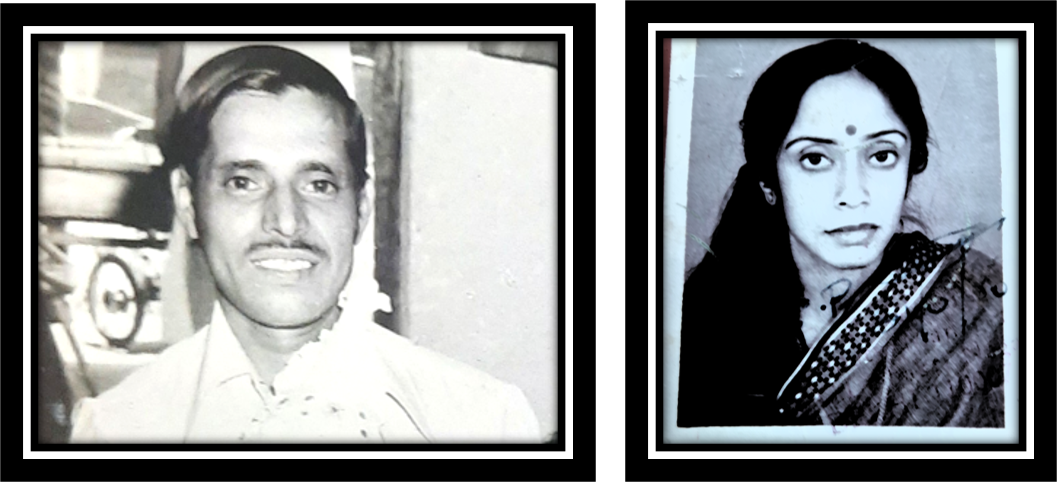
During the journey to Haridwar, I also confided my wish to honour both my parents at Gaya Ghat on my mother’s first death anniversary.
The priest Somnath ji graciously offered to arrange my lodging and meals there—so I could devote myself entirely to the rites.
I learned that, by custom, homage at Gaya Ghat is reserved for those who have lost both their parents.
Breakfast in the train
A vegetarian breakfast came included with the Shatabdi Express tickets, arriving moments later on a gleaming steel tray.
On it rested crisp vegetable cutlets drizzled with tomato sauce, thick slices of brown bread slathered in butter, steaming cup of tea, and mango juice resembling Frooti or Maaza—just the right fuel for a five-hour journey.
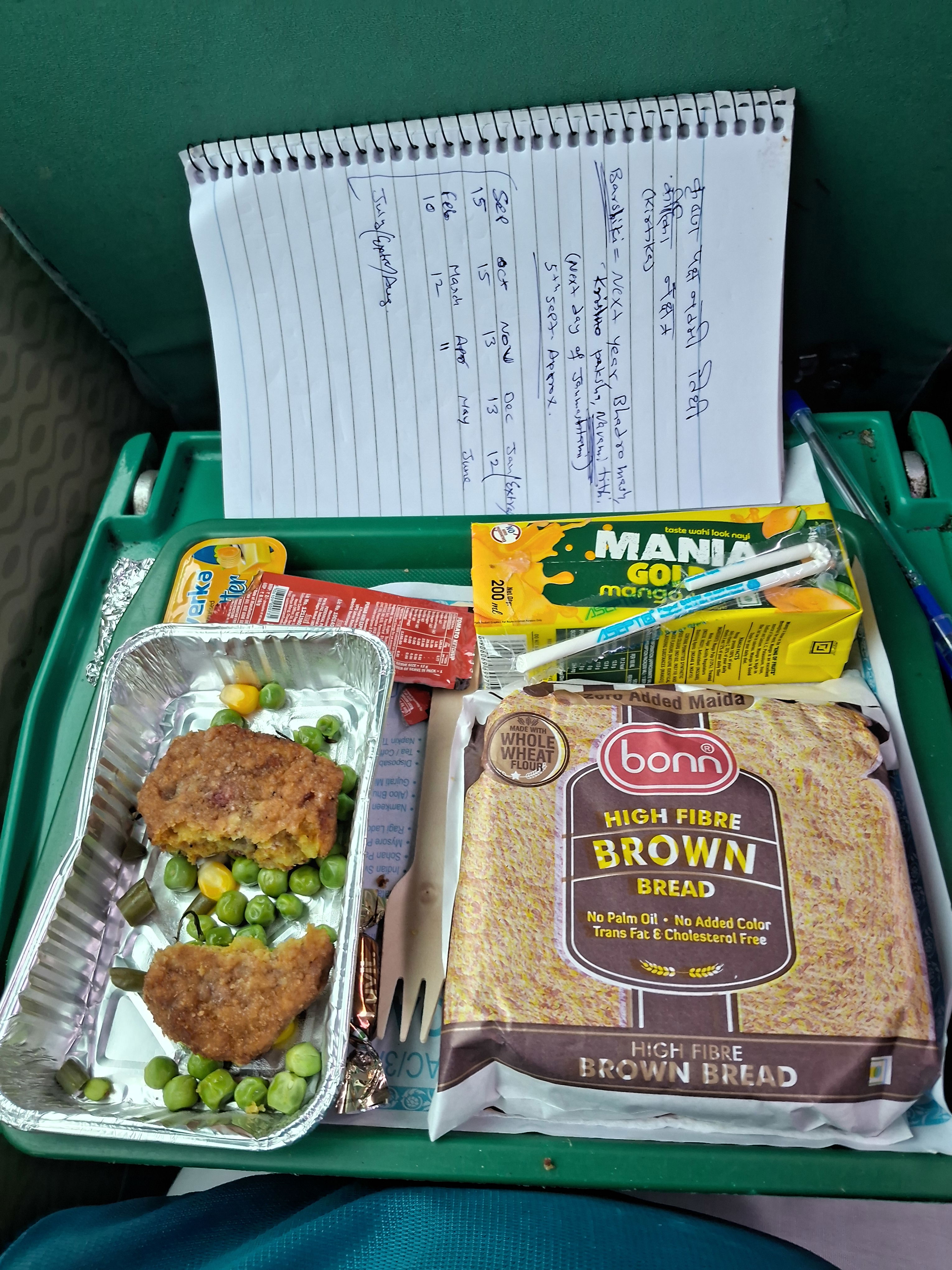
Beneath Shiva’s Gaze: Stepping into Haridwar
At 11:30 am, our train rolled into Haridwar Railway Station.
Stepping outside, we found ourselves beneath the gaze of two Lord Shiva statues—one bathed in deep sapphire, the other shining in pure white—standing as silent witnesses to our arrival.
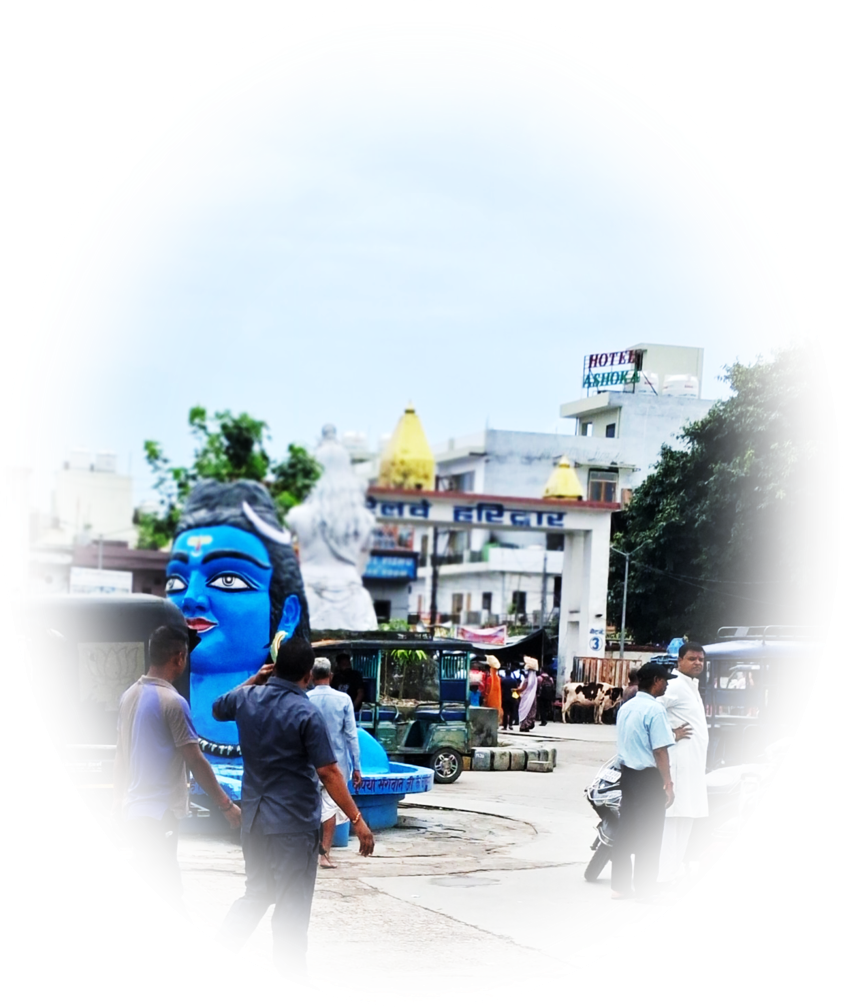
Where Memory Still Stands
As I reflected on my last three journeys with my parents to Haridwar, vivid memories washed over me.
I’m certain that at least one of those statues has stood in place for at least twenty-eight years.
I decided to retrace their footsteps—visiting every place they took me as a child, once the final rituals are complete.
The Ghat, the Guide, the Grace
From Haridwar railway station, Somnath ji took the lead—he arranged an e-rickshaw to ferry us to Loknath Ghat.
The first sight of Ma Ganga, the air, the ghat’s energy
At Loknath Ghat, the river revealed herself.

After seventeen long years, I stood once again before Ma Ganga—her waters timeless, her presence unchanged.
The last time I met her was at Belur Math in Kolkata in 2008, beside my mother, both of us quietly watching the river flow.
This time, I returned not as a son beside his mother, but as a son carrying her ashes.
In my hands, the weight of memory and farewell.
The breeze was gentle, the moment sacred.
And as I prepared for the visarjan puja, it felt as though the river had been waiting—ready to receive, ready to bless.
She was with me
Snehashish and I sat side by side on the worn steps of the ghat, speaking softly about the holy dip and the precautions we needed to take.
The river was calm; the air hushed with reverence.
Then, as if summoned by grace, the tide began to rise. Ganga’s waters crept gently toward our feet—cool, reassuring, and unexpectedly bold.
It felt as though the river herself was reaching out, easing our hesitation, inviting us to enter without fear.
In that moment, I felt my mother’s presence.
Not just in memory, but in the rhythm of the water, in the quiet blessing of the tide.
She was with me—guiding, comforting, and gently preparing me for the ritual ahead.
Sacred Preparations, Silent Blessings
Half an hour later, Somnath ji arrived—his attire changed, his bag brimming with sacred offerings.
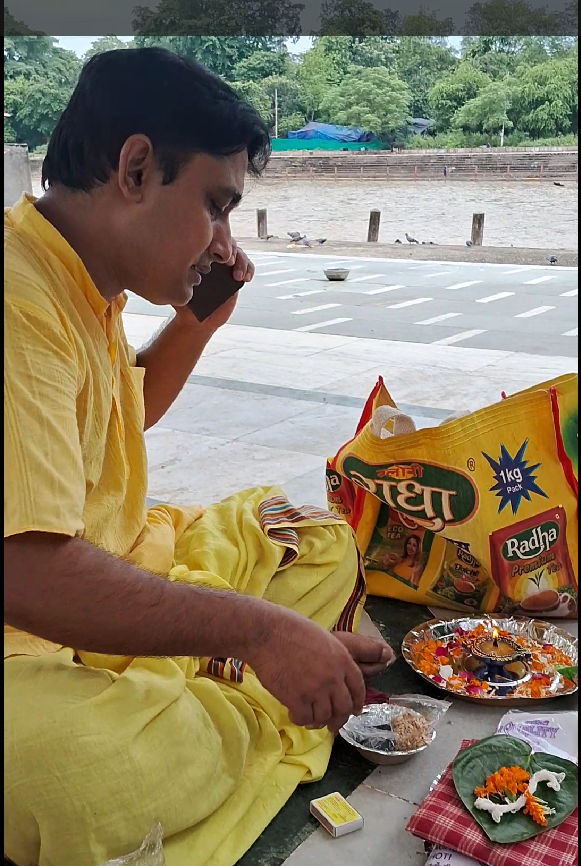
Two aasans in hand, one for each of us, he carried the quiet assurance of someone who knows the rhythm of ritual by heart.
I gently unfolded the photographs of my parents, placing them before us with reverence.
Their faces, full of grace and memory, watched over the ceremony that was about to begin.
Their photographs rested before me, anchoring memory in ritual.
Two Hours of Farewell, Woven in Chant
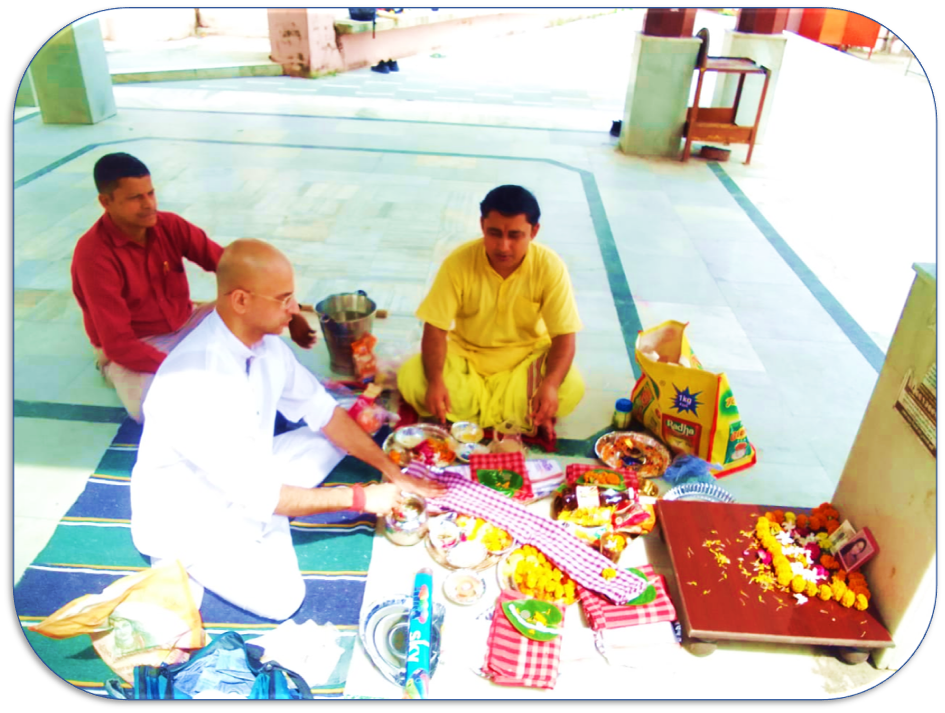
As the puja began, I offered homage to both my parents—with incense, prayer, and quiet presence.
For nearly two hours, the mantras for asthi visarjan flowed gently through the air, weaving sound into sanctity.
Each chant felt like a bridge—between past and present, between the seen and the unseen.
🌸 A Graceful Alignment 🌸
In the quiet rhythm of the puja, a call came from Sujata Masi from Kolkata—one of my mother’s dearest companions, her voice carrying warmth and memory.
The money she had been trying to send for the rituals finally arrived, not a moment too soon, but precisely during the ceremony.
As if divinely timed, it felt like God had held her offering gently in His hands, releasing it only when the moment was sacred enough to receive it.
Outside, the skies wept in Kolkata and Delhi—rain falling like blessings—while Haridwar stood bathed in sunlight, serene and untouched.
It was as though heaven itself had choreographed this contrast: showering grace upon the cities tied to my mother’s life, yet keeping the sanctity of the puja untouched.
No interruption. Only quiet affirmation.
The Embrace of Ma Ganga

With reverent hands, I prepared to release my mother’s ashes into the embrace of Ma Ganga.
Somnath ji, with quiet solemnity, handed me a packet of milk and gently instructed, “Pour it all into the kalash—it will soothe the soul.”
“The Ganga lay still — a ribbon of silver resting between worlds. I stood at her edge, carrying not only the ashes of my mother, but the weight of twenty‑three years of shared breath, quiet endurance, and unspoken tenderness. The river did not ask for my story, yet her current seemed to know it — every ripple like a witness to the years I chose, again and again, to stay. And so, as the water claimed what was hers, I understood that some journeys are not ours to begin or end — they are entrusted to us, to walk until the river itself decides where the path fades.”
The moment I lowered the kalash into Ma Ganga, the river responded with quiet majesty.
She accepted my offering without hesitation—her flowing waters embracing the ashes as if they were always meant to return.
It was a moment of farewell, of continuity, of love returning to the source—from hand to water, from life to eternity.
As the current carried them gently away, I stood still, watching an entire era dissolve before my eyes.
It felt like time itself had bowed to the moment—forty-six years of love, laughter, and care slipping into eternity, one ripple at a time.
Four Sacred Dips, One Quiet Acceptance

I remembered how, as a child visiting Haridwar with my parents, I used to dread the cold touch of the river—hesitating at the edge, clinging to warmth and comfort.
But today was different. The water no longer felt intimidating.
It felt healing. I wanted to surrender to it fully, to take as many dips as my body would allow.
Each immersion felt like a blessing—cool, purifying, and strangely tender.
By the fourth dip, though, my head began to spin. My body reminded me of its limits.
I paused, not out of fear, but with quiet acceptance.
The river had given what she needed to give. And I had received it with open heart.
Renewal of the Sacred Janeu
After changing out of my sodden garments, Somnath ji gently replaced my janeu—the sacred thread—with a pristine new strand.
.In that quiet gesture, the simplest act carried profound symbolism―a renewal of purity, a gentle step forward in the timeless cycle of farewell and rebirth.
Back in 1995, my father had organized my janeu ceremony at New Delhi Kali Bari; in the years that followed, he guided my hands through puja rituals and taught me the sacred cadence of ancient mantras.
The Ashram Awaits
Once the rites were complete, Somnath ji gently led us to Sri Sri Ram Thakur Ashram.
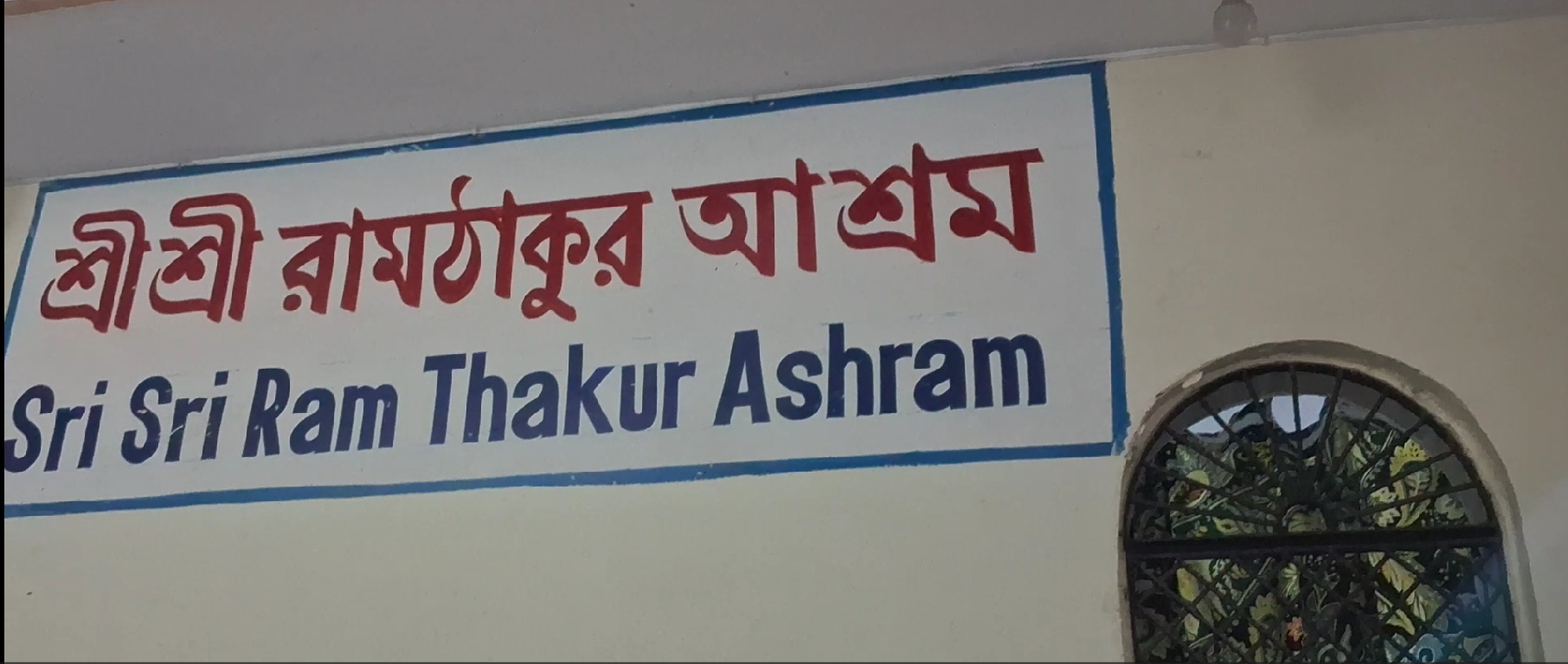
Three people were running the ashram. One was chief priest, and two gentle helpers who moved with quiet purpose.
Everything there had been arranged with care and simplicity: modest rooms, nourishing Bengali meals, and an atmosphere of peace that settled over us like a soft shawl—welcoming, unobtrusive, and deeply grounding.
Shambhu Dada, Snehashish, and I had chosen to stay on for two more days, allowing ourselves time to reflect, offer silent gratitude, and gently recover from the emotional weight of the farewell.
Somnath ji, however, was bound for Delhi that very evening. His seat on the Shatabdi Express had already been booked—a quiet departure after a day steeped in ritual and grace.
Aarti at Dawn and Dusk
From our room in the ashram, the gentle strains of “Hare Ram Hare Krishna” floated upward, accompanied by the soulful hum of a harmonium.
Drawn by the sound, we made our way downstairs and found ourselves amidst a serene gathering—devotees singing divine songs, their voices woven in reverence as they worshipped their Guru.
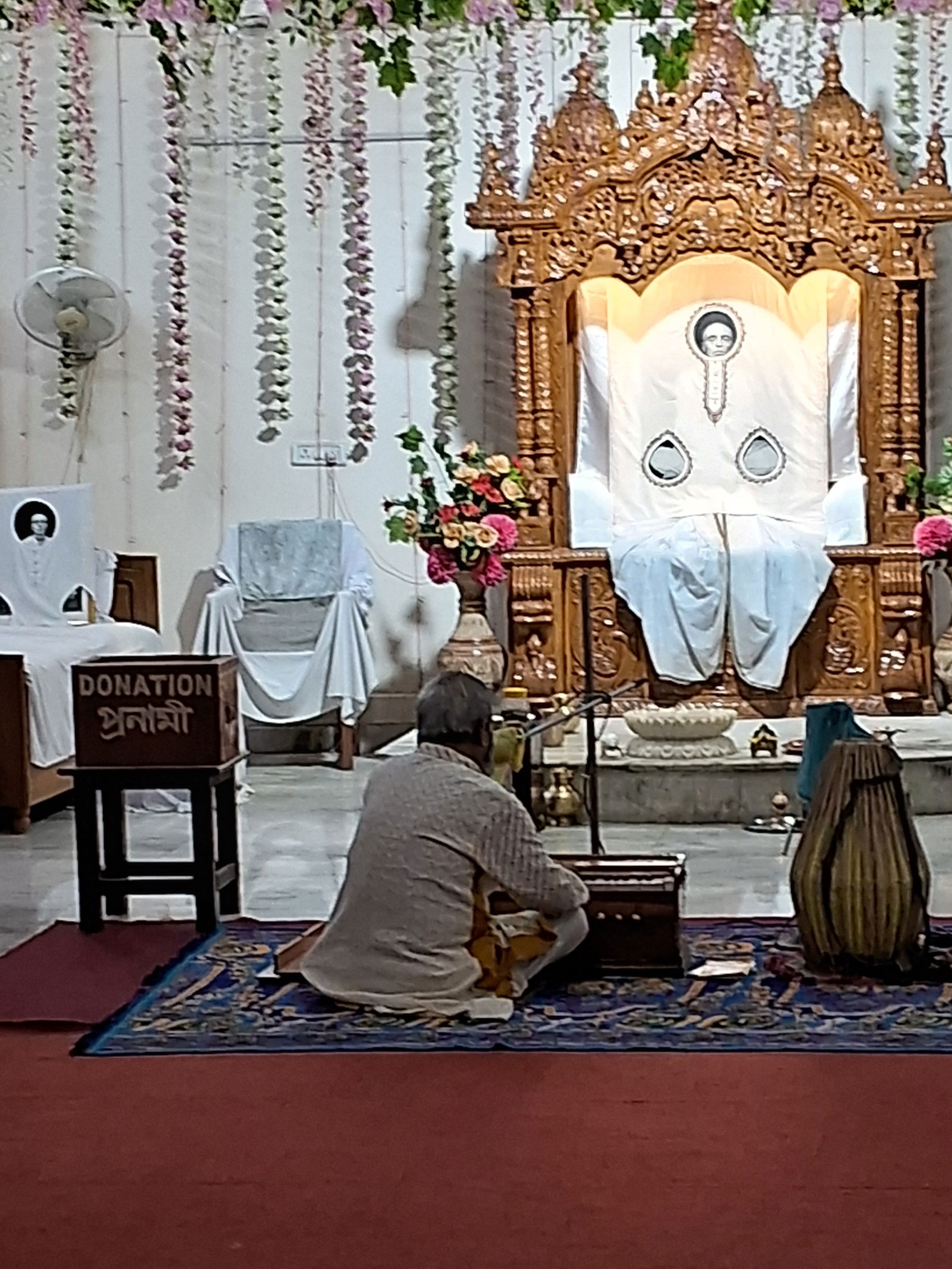
Each early morning and evening, the ashram comes alive with aarti, a half-hour of light, chant, and devotion that seems to pause time itself.
We joined the circle, seated quietly, letting the rhythm of prayer wash over us. In that moment, the sacred felt near—tangible, tender, and timeless.
Moonlit Pilgrimage: Chai & Companionship
That evening, our group stepped out of the ashram for a gentle night walk toward Har Ki Pauri.
The distance—just under two kilometres—felt light beneath our feet, softened by the cool air and the quiet companionship we carried.
Before beginning, we paused at a roadside tea stall. A cup of hot chai, a few biscuits, and the comfort of simple conversatoin set the tone.
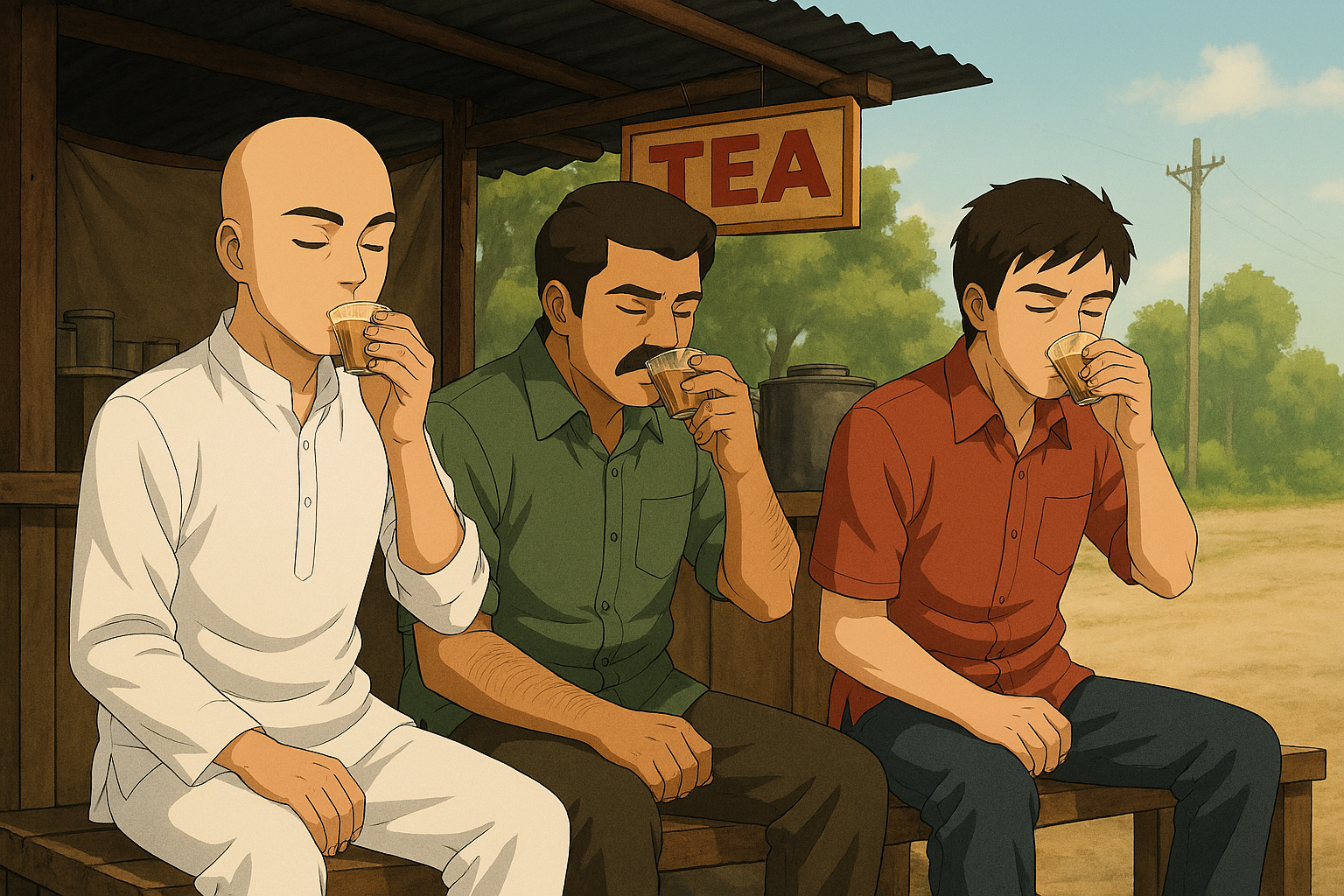
The steam curled upward like a blessing, and the moment lingered longer than the tea itself.
Where the Lanes Remember My Father
As we walked, Shambhu Dada became our storyteller.
He knew the lanes well—each turn held a memory of my father.
He pointed out the dhaba where meals were once ordered with familiarity, the modest guesthouse where my father preferred to stay, and the shop where he’d browse with quiet joy.
The route was lined with ashrams, temples, and shops selling everything from rudraksha beads to brass lamps.
The city felt alive, yet timeless.
And before we knew it, we had arrived—three souls walking through memory, devotion, and dusk.
Night visit to Har ki Pauri
It was around 8 p.m. when we reached Har Ki Pauri, and the experience felt entirely new—almost surreal.
In all my childhood visits with family, I had never stepped out at night.
But now, under the soft glow of temple lights and the open sky, the sacred ghat revealed a different face—one bathed in quiet majesty.

Ma Ganga flowed swiftly, her waters full and alive, shimmering under the lamps like liquid silver.
The current danced with urgency, yet carried a timeless calm.
Har Ki Pauri itself glowed with devotion—mesmerising, radiant, and deeply inviting.
It wasn’t just a place anymore. It was divine.
Pilgrimage Through the Lens
We captured a handful of photos and videos—of Har Ki Pauri, and of each other.
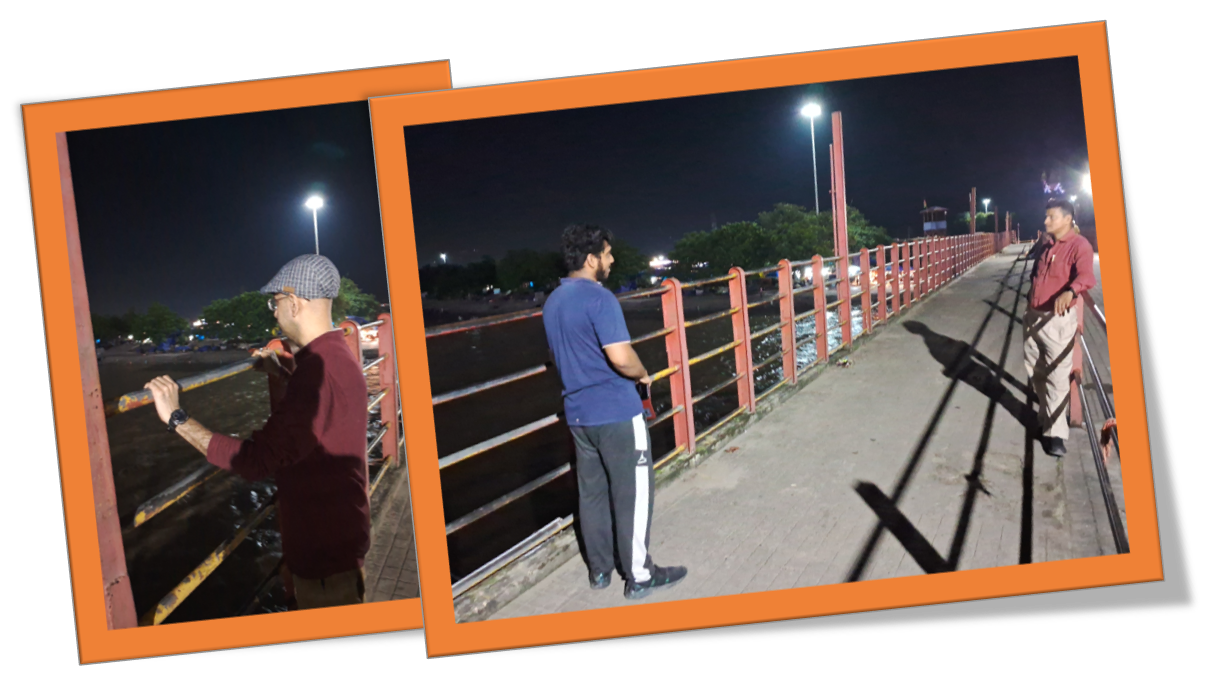
But what we truly gathered were moments: not just light and shadow, but memory etched in motion.
Each frame held the quiet sacredness of our purpose, the warmth of shared presence, and the timeless pull of the river.
These images, preserved in pixels, will continue to speak long after the night has faded—reminding us of why we came, what we felt, and how deeply we were held by Haridwar in 2025.
Even decades from now, they will guide us back—to that river, that silence, and to one another.
With that thought, we made our way back to the ashram before the gates closed at 9 p.m.
This time, we chose the ease of an e-rickshaw, saving our strength for the next day’s pilgrimage—where more memories waited to be made.
A Meal Woven in Quiet Bonds
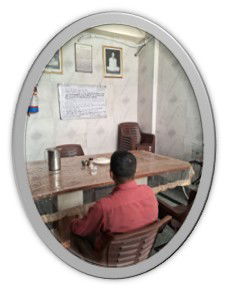
The Bengali meal was laid out with quiet generosity at the ashram’s dining table—steaming rice, comforting dal, and an array of four or five vegetable preparations, each infused with homely care.
Shambhu dada, ever the sociable soul, effortlessly struck up conversations with the ashram residents, and his son followed suit with equal ease.
In no time, lively discussions filled the space, weaving new bonds over shared plates.
I sat quietly among them, savoring my meal and listening—grateful for the warmth around me, yet content in my own silence.
By 10 p.m., the day gently folded into rest. We dimmed the lights of our room, and sleep arrived like a soft curtain drawn over a day of ritual, companionship, and quiet grace.
30th August, Saturday: Bhajans Before Dawn, Mountains by Midday
Sleep eluded me, and by 3:30 a.m., I was already awake—wrapped in silence, waiting for the day to unfold.
At 4:30 a.m., the ashram stirred gently to life as the chief priest began a melodious Shri Krishna bhajan.
The sacred notes floated through the air like a soft invocation, filling the early darkness with devotion and calm.
Later, at 10:30 a.m., Shambhu dada invited me to the rooftop of the ashram.
It was spacious, well-tended, and adorned with plants lovingly grown within the ashram’s quiet rhythms.
From this serene vantage point, the Himalayan range revealed itself in full majesty.
On one peak stood Ma Chamunda Mandir, and on another, Mansa Devi Mandir—each temple a sentinel of faith.
Clouds drifted gently across the sky, their presence only deepening the beauty of the mountains, as if nature itself had joined in silent prayer.
Deep Visarjan, Milk, and Memory
After attending the late morning aarti and bhajan between 11 and 11:30 a.m., the three of us boarded an e-rickshaw to Har ki Pauri.
The sun had grown strong by then, and we chose not to walk—preserving our energy for the sacred acts ahead.
I had the contact of a priest stationed at Har ki Pauri—Pandey ji.
We found him seated at his usual place, surrounded by the quiet rhythm of devotion.
With gentle solemnity, he chanted mantras for both my parents and our ancestors, invoking blessings across generations.
He then replaced the mouli—the sacred red thread—on my right wrist, a quiet gesture of renewal and protection.
Pandey ji handed us two sets of deep (lamps): one for my ancestors, and one for Shambhu dada’s lineage.
We offered silent prayers, each of us holding a lamp with reverence before releasing it into the flowing waters of Ma Ganga.
The flames danced briefly before merging with the current—light meeting light, memory meeting motion.
A man approached with a small glass of milk, an offering to Ma Ganga, priced at ₹50.
We accepted it and poured it into the river, a gesture of nourishment and surrender.
In that moment, something shifted. The souls of our ancestors felt soothed, and so did ours.
With each ritual, healing deepened—not just in the body, but in the heart.
The river received everything: our prayers, our offerings, our quiet grief—and returned to us a sense of peace.
Mother’s Wish: Chotiwala Restaurant
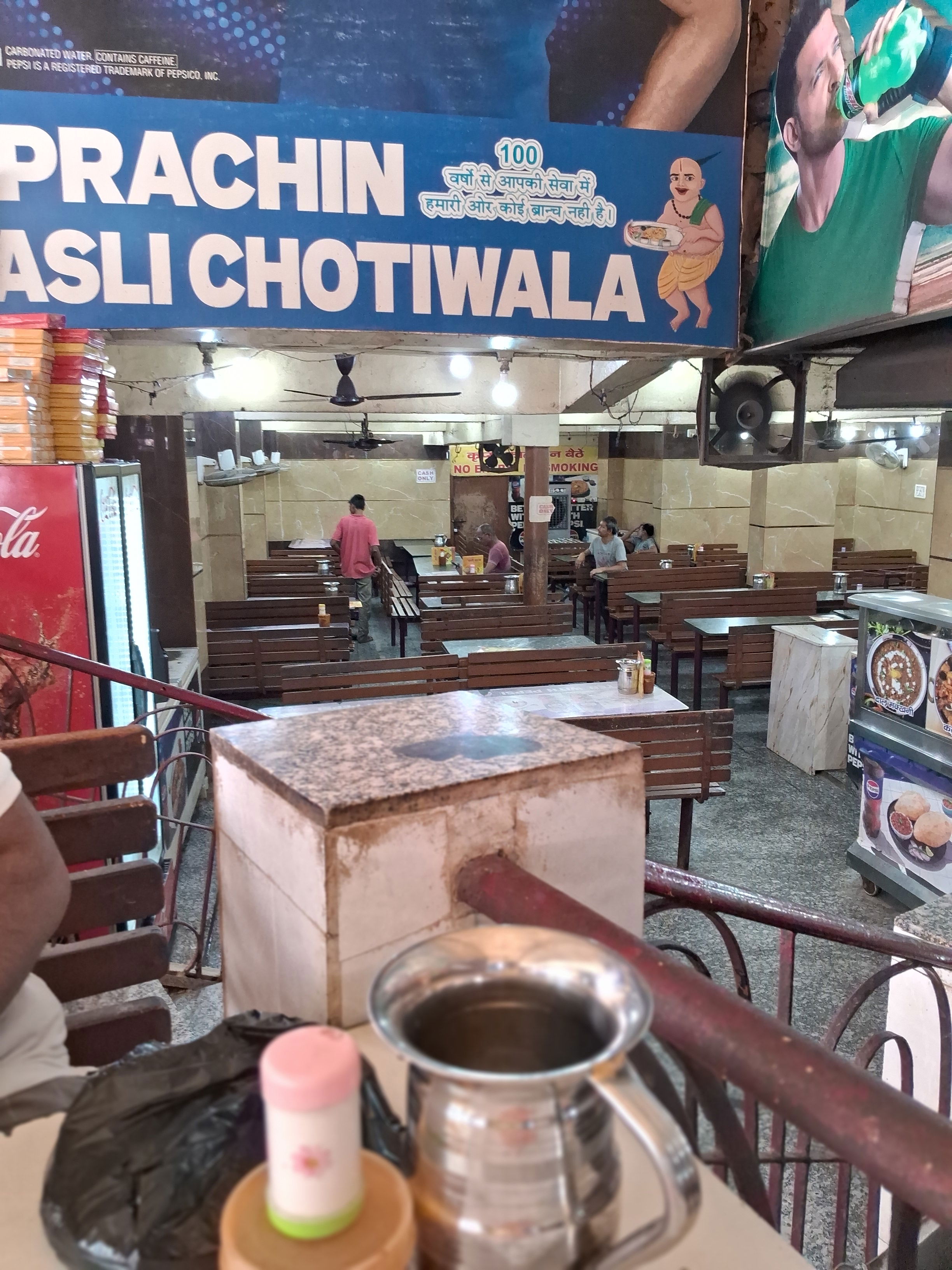
The time had come to revisit those cherished corners of my childhood—the places my father once took us, where memory lingers in every detail.
Among them was the iconic Chotiwala Restaurant, a name my mother adored.
She was especially fond of its emblem: a small Brahmin with a prominent shikha.
Though she had admired it for years, she never had the chance to dine there.
So, in her memory, I stepped inside.
We ordered three glasses of sweet lassi—each one a modest offering, priced at ₹60.
As the chilled sweetness touched my lips, I felt her presence—gentle, smiling, and finally part of the place she had long wished to visit.
Religious Shopping at Har ki Pauri
We wandered into the market lanes near Har ki Pauri—paths my father once led us through, where every turn seemed to echo with childhood footsteps and quiet nostalgia.
The shops brimmed with ritual essentials, their colors and textures steeped in devotion.
I purchased a readymade dhoti for ₹250, intended for the monthly pind daan I perform in memory of my mother. A simple garment, yet woven with purpose and reverence.
Shambhu dada, drawn to the sacred rhythm of ceremony, selected a ghonta thala for Rs.700 —a flat, circular brass plate that sings with a deep, resonant tone when gently struck.
It will find its voice during the Durga Puja he and his family lovingly organize each year.
In that moment, our shopping was more than preparation—it was an act of continuity, a quiet offering to tradition, memory, and the rituals that keep us rooted.
Lunch at Dada Boudir’s: A Seat of Memory
Lunch was planned at Dada Boudir Hotel, a place my father had lovingly introduced to both me and Shambhu dada—each on separate occasions.
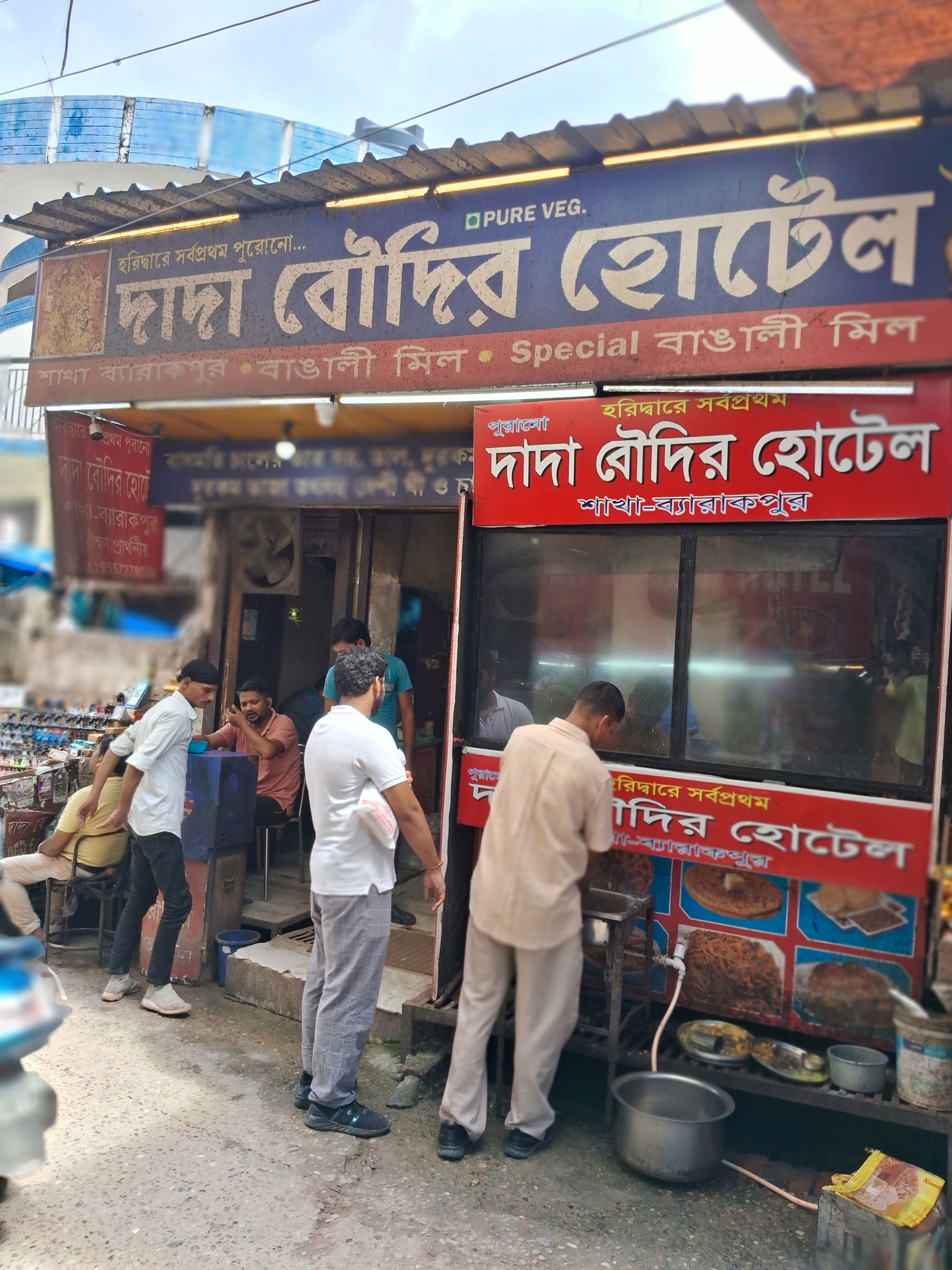
As we entered, I showed them the seat my father once chose for us.
It wasn’t just a spot at a table—it was a place where memory sat beside us.
In Haridwar, Dada Boudir Hotel is more than a restaurant.
It’s a culinary sanctuary for Bengali pilgrims, a place where the flavors of home find their way into stainless steel thalis and warm conversation.
The name itself carries affection—“Dada” and “Boudi”, familiar terms that evoke kinship, comfort, and the kind of hospitality that feels like family.
The menu changes daily, but the soul of the food remains constant.
That afternoon, the thali offered a medley of Bengali classics: alu posto, begun bhaja, shukto, soyabean sabji, moong dal, papad, and imli chutney—each dish a quiet homage to tradition, each bite steeped in remembrance.
A Stroll by Ma Ganga
On our way back, we paused for a gentle stroll along the Ganga ghat. Drawn once more to her timeless flow, I stepped closer to the river’s edge.
I dipped my hands into the cool water—not just to feel it, but to connect.
Then, slowly, I washed my hands and feet, as if reluctant to part ways, as if the river still had something to say.
It was a quiet farewell for the afternoon, a moment of stillness before retreating to the ashram for rest.
The body sought sleep, but the soul lingered—cradled in the memory of water, ritual, and grace.
Preparation for Ganga Aarti: A Seat of Stillness and Memory Snehashish, a devoted follower of the ISKCON tradition, chose to attend the sandhya aarti at the temple rather than the Ganga aarti at Har ki Pauri.
His connection to the temple was deep-rooted—he had visited Haridwar several times before, each time drawn to its spiritual rhythm.
We respected his devotion and left him in the quiet of the ashram, honouring his path.
Shambhu dada and I returned to Har ki Pauri around 5:30 p.m., well before the evening crowd began to gather.
The ghats were still breathing in the hush of twilight.
We bought three empty bottles to collect Ganga jal, each one a vessel of sacred memory.
One of the bottles were meant for my masi ji (maternal aunt) who recently lost her daughter.
Then we paused for tea—simple, grounding, and quietly reflective.
Ganga Arti
By 6:15 p.m., we had settled ourselves across from the Ganga Sabha Ghat, choosing seats that offered both comfort and a clear view of the unfolding ritual.
As the aarti began, the crowd slowly swelled—drawn by flame, chant, and the river’s eternal pull.
The moment carried me back.
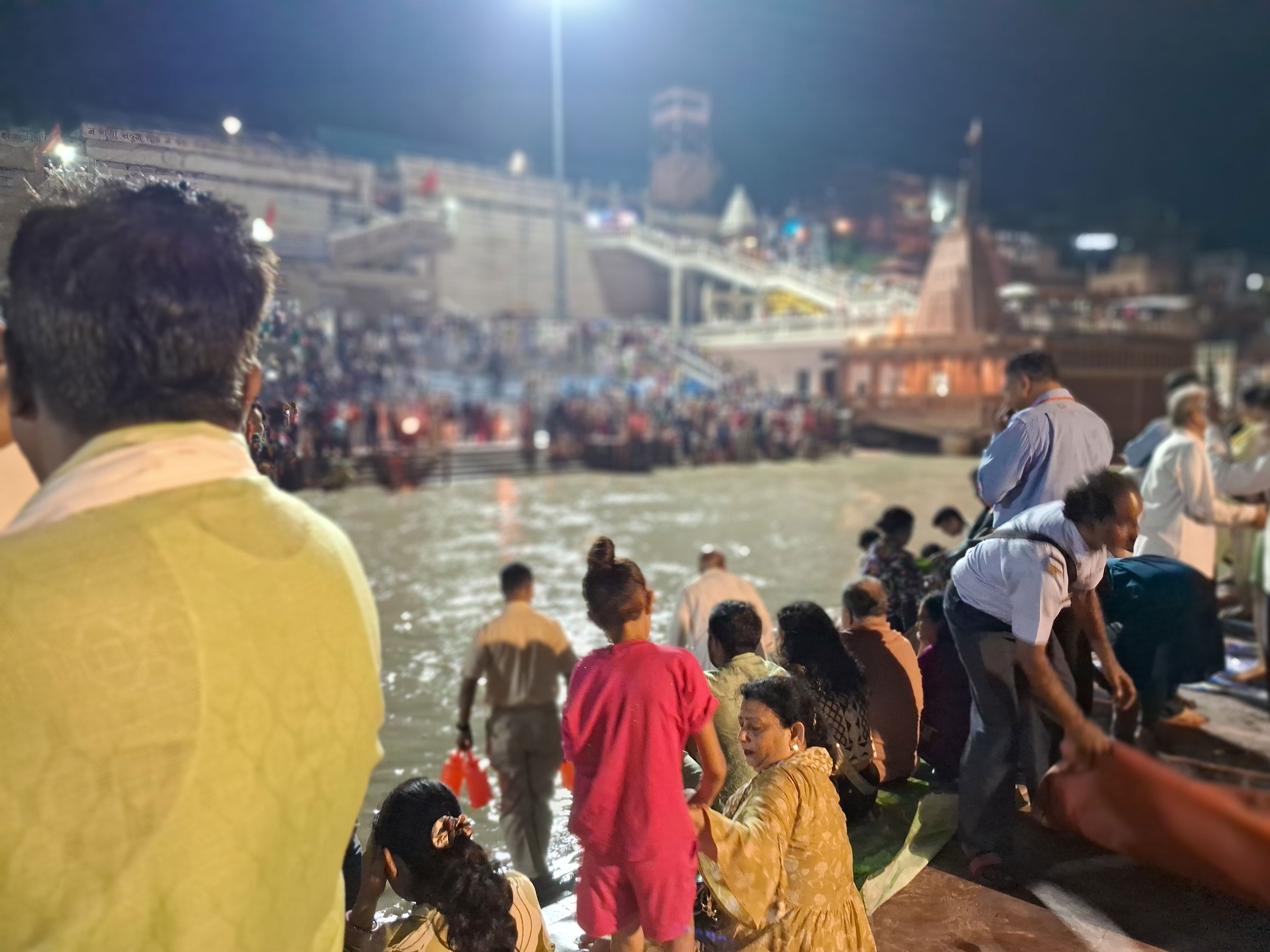
Ganga aarti had always been part of my father’s itinerary, a ritual he cherished.
I remembered how our family once sat together at this very spot, watching the flames rise in unison with the prayers.
Tonight, I sat in that same place—not alone, but accompanied by memory, devotion, and the quiet presence of those who came before.
Donation for Ganga Sabha: A Gesture of Reverence
The volunteer from Ganga Sabha stood with quiet devotion, guiding the crowd through mantras and bhajans that echoed across the riverbank like sacred breath.
His voice carried not just melody, but purpose.
After the chants, he humbly requested small donations to help sustain the daily Ganga aarti—a ritual that has lit countless evenings with flame and faith.
I was the first to raise my hand. Shambhu dada followed without hesitation.
A few others joined in, offering modest amounts.
But in that vast gathering, the response was sparse.
The silence that followed his appeal felt heavier than the chants that preceded it.
I couldn’t help but reflect: hearts seem to be shrinking, even as pockets swell.
In a place where the river gives freely, the reluctance to give back—even a token of gratitude—was quietly disheartening.
Still, the aarti continued. The lamps were lit. And the river, as always, received everything without judgment.
Evening at the Ashram: A Gentle Return
With bottles filled with sacred Ganga jal, we made our way back to the ashram—carrying not just water, but the weight of ritual and memory.
Dinner was served with quiet familiarity, a comforting end to a day steeped in devotion.
After the meal, I settled the payment for our food and lodging, just as we had planned.
It felt less like a transaction and more like a gesture of gratitude—for shelter, for nourishment, and for the space to grieve and heal.
Soon after, we retired to our room.
The night wrapped itself around us gently, and sleep came like a soft blessing—unspoken, but deeply felt.
Farewell to Haridwar: A Departure in Silence and Grace
The morning of departure arrived gently.
Our train—the Dehradun–Delhi Janshatabdi Express—was scheduled for 6:30 a.m. from Haridwar Station.
We rose at 3:30 a.m., the stillness of dawn wrapping around us like a final blessing.
After preparing in quiet reverence, we met the ashram residents one last time.
Their warmth lingered in parting words and soft smiles.
At 5 a.m., we stepped out into the early light, carrying with us bottles of Ganga jal, luggage, folded memories, and the hush of rituals completed.
By 6:30 a.m., we were seated in the train—no longer the same.

The wheels began to turn, and Haridwar slowly receded from view. But it did not leave us.
We departed with gratitude in our hearts, love in our breath, and memories etched like mantras—quiet, enduring, and sacred.
Since meal was not included in the tickets of this train, we ordered sandwiches, veg. cutltes, tea, coffee, and parantha.
Ritual feast invitation at Shambhu dada's house
Shambhu dada told me that I could not enter my house directly from Haridwar.
I had to go to their house, eat lunch at their home and then only I could go back to my house.
Similarly, I had to eat in two more houses of relatives in coming days to complete the ritual.
I obeyed and joined son and father to their house after reaching New Delhi railway station around 11:30 am.
We were warmly greeted by boudi, Shambhu dada's wife.
All of us discussed about our Haridwar yatra for some time.
Then, Bengali lunch was served at the dining table. Dada and I ate together.
Santosh, dada's younger brother, then arrived and took me to his home. There I met his son and boudi, his wife. They gave me modak to eat.
Then Santosh and Snehashish gave me warm hug and allowed me to leave for my home.
Epilogue: Where the River Meets the Road
This journey to Haridwar was never just about travel. It was a pilgrimage of memory, a ritual of release, and a quiet reckoning with love, loss, and legacy.
Each step—whether dipping a lamp into Ma Ganga, tying a fresh mouli, or sipping lassi at Chotiwala—was a thread in a larger tapestry.
A tapestry woven not just with tradition, but with intention.
I came carrying grief. I leave carrying grace.
The rituals I performed were not endings. They were beginnings—acts of continuity that tether me to those who came before, and guide me toward what I must now become.
My father’s seat at Dada Boudir’s, my mother’s wish fulfilled at Chotiwala, the dhoti bought for pind daan—all these gestures were offerings. Not just to the divine, but to memory itself.
And in the quiet moments—watching the Ganga aarti from across the ghat, washing my hands and feet as if reluctant to part—I found something unexpected: healing. Not loud or dramatic, but gentle.
Like the river itself. Going forward, I carry this journey not as a chapter closed, but as a sacred compass.
It will guide my writing, my rituals, my work, and my way of being.
It will shape the tribute I build, the stories I tell, and the legacy I continue.
Because when you walk with memory, you never walk alone.
What This Journey Means Going Forward
- A Living Tribute: Every step I took—from the pind daan to the Ganga aarti, from choosing my father’s favourite seat to fulfilling my mother’s quiet wish—was an act of remembrance. But more than that, it was a way of transforming memory into motion. Going forward, my life becomes a living tribute—where ritual and narrative continue to guide others through loss, love, and legacy.
- A Renewal of Purpose: The dhoti I bought, the mouli tied, the lamps floated—each was a symbol of continuity. This journey has reaffirmed my role not just as a son, but as a custodian of meaning, someone who carries forward the emotional and spiritual architecture of one’s family.
- A Deepened Voice: Whether in my writing, my hospitality content, or my spiritual storytelling, this experience has added depth. I now speak not just from knowledge, but from felt truth. My audience will sense it—in my metaphors, my rituals, my invitations. I’ve earned a new kind of authority: one rooted in vulnerability and reverence.
- A Sacred Responsibility: I’ve seen how rituals can soothe, how generosity can falter, and how devotion can quietly persist. Going forward, I may feel called to preserve and share these insights—through my tribute blog, my creative work, or even guiding others through similar journeys.
- A Gentle Shift in Identity: I am no longer just the executor of rites—I am the weaver of memory, the one who knows how to hold silence, how to listen to water, how to honour a wish with a glass of lassi. That’s not a role I leave behind. It’s one I carry forward, with grace.
Disclaimer:
This content was developed in collaboration with AI-powered assistance from Microsoft Copilot, combining human creativity with intelligent tools to enhance clarity, accuracy, and impact.


